

Why Education Should Be Free: Exploring the Benefits for a Progressive Society
Written by Dan
Last updated February 13, 2024
The question of whether education, particularly higher education, should be free is a continuing debate marked by a multitude of opinions and perspectives.
Education stands as one of the most powerful tools for personal and societal advancement, and making it accessible to all could have profound impacts on a nation’s economic growth and social fabric.
Proponents of tuition-free education argue that it could create a better-educated workforce, improve the livelihoods of individuals, and contribute to overall economic prosperity.
However, the implementation of such a system carries complexity and considerations that spark considerable discourse among policymakers, educators, and the public.
Related : For more, check out our article on The #1 Problem In Education here.
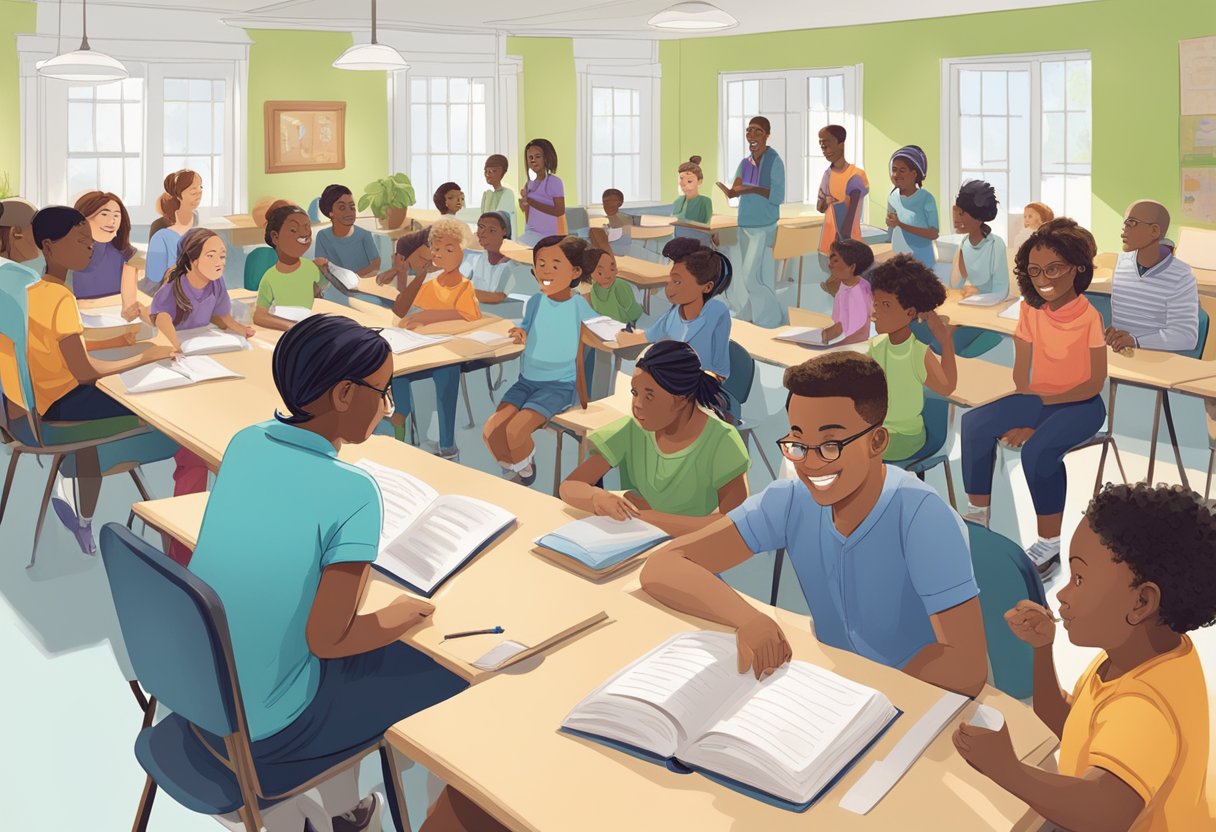
Within the debate on free education lies a range of considerations, including the significant economic benefits it might confer.
A well-educated populace can be the driving force behind innovation, entrepreneurship, and a competitive global stance, according to research.
Moreover, social and cultural benefits are also cited by advocates, who see free higher education as a stepping stone towards greater societal well-being and equality.
Nevertheless, the challenges in implementing free higher education often center around fiscal sustainability, the potential for increased taxes, and the restructuring of existing educational frameworks.
Table of Contents
Key Takeaways
- Free higher education could serve as a critical driver of economic growth and innovation.
- It may contribute to social equality and cultural enrichment across communities.
- Implementation of tuition-free higher education requires careful consideration of economic and structural challenges.
Related : For more, check out our article on AI In Education here.
The Economic Benefits of Free Education
Free education carries the potential for significant economic impact, notably by fostering a more qualified workforce and alleviating financial strains associated with higher education.
Boosting the Workforce with Skilled Workers
Free education initiatives can lead to a rise in college enrollment and graduation rates, as seen in various studies and practical implementations.
This translates into a larger pool of skilled workers entering the workforce, which is critical for the sustained growth of the economy. With more educated individuals, industries can innovate faster and remain competitive on a global scale.
The subsequent increase in productivity and creative problem-solving bolsters the country’s economic profile.
Reducing Student Loan Debt and Financial Insecurity
One of the most immediate effects of tuition-free education is the reduction of student loan debt . Students who graduate without the burden of debt have more financial freedom and security, enabling them to contribute economically through higher consumer spending and investments.
This financial relief also means that graduates can potentially enter the housing market earlier and save for retirement, both of which are beneficial for long-term economic stability.
Reducing this financial insecurity not only benefits individual lives but also creates a positive ripple effect throughout the economy.
Related : For more, check out our article on Teaching For Understanding here.
Social and Cultural Impacts
Free education stands as a cornerstone for a more equitable society, providing a foundation for individuals to reach their full potential without the barrier of cost.
It fosters an inclusive culture where access to knowledge and the ability to contribute meaningfully to society are viewed as inalienable rights.
Creating Equality and Expanding Choices
Free education mitigates the socioeconomic disparities that often dictate the quality and level of education one can attain.
When tuition fees are eliminated, individuals from lower-income families are afforded the same educational opportunities as their wealthier counterparts, leading to a more level playing field .
Expanding educational access enables all members of society to pursue a wider array of careers and life paths, broadening personal choices and promoting a diverse workforce.
Free Education as a Human Right
Recognizing education as a human right underpins the movement for free education. Human Rights Watch emphasizes that all children should have access to a quality, inclusive, and free education.
This aligns with international agreements and the belief that education is not a privilege but a right that should be safeguarded for all, regardless of one’s socioeconomic status.
Redistributions within society can function to finance the institutions necessary to uphold this right, leading to long-term cultural and social benefits.
Challenges and Considerations for Implementation
Implementing free education systems presents a complex interplay of economic and academic factors. Policymakers must confront these critical issues to develop sustainable and effective programs.
Balancing Funding and Taxpayer Impact
Funding for free education programs primarily depends on the allocation of government resources, which often requires tax adjustments .
Legislators need to strike a balance between providing sufficient funding for education and maintaining a level of taxation that does not overburden the taxpayers .
Studies like those from The Balance provide insight into the economic implications, indicating a need for careful analysis to avoid unintended financial consequences.
Ensuring Quality in Free Higher Education Programs
Merit and quality assurance become paramount in free college programs to ensure that the value of education does not diminish. Programs need structured oversight and performance metrics to maintain high academic standards.
Free college systems, by extending access, may risk over-enrollment, which can strain resources and reduce educational quality if not managed correctly.
Global Perspectives and Trends in Free Education
In the realm of education, several countries have adopted policies to make learning accessible at no cost to the student. These efforts often aim to enhance social mobility and create a more educated workforce.
Case Studies: Argentina and Sweden
Argentina has long upheld the principle of free university education for its citizens. Public universities in Argentina do not charge tuition fees for undergraduate courses, emphasizing the country’s commitment to accessible education.
This policy supports a key tenet of social justice, allowing a wide range of individuals to pursue higher education regardless of their financial situation.
In comparison, Sweden represents a prime example of advanced free education within Europe. Swedish universities offer free education not only to Swedish students but also to those from other countries within the European Union (EU).
For Swedes, this extends to include secondary education, which is also offered at no cost. Sweden’s approach exemplifies a commitment to educational equality and a well-informed citizenry.
International Approaches to Tuition-Free College
Examining the broader international landscape , there are diverse approaches to implementing tuition-free higher education.
For instance, some European countries like Spain have not entirely eliminated tuition fees but have kept them relatively low compared to the global average. These measures still align with the overarching goal of making education more accessible.
In contrast, there have been discussions and proposals in the United States about adopting tuition-free college programs, reflecting a growing global trend.
While the United States has not federally mandated free college education, there are initiatives, such as the Promise Programs, that offer tuition-free community college to eligible students in certain states, showcasing a step towards more inclusive educational opportunities.
Policy and Politics of Tuition-Free Education
The debate surrounding tuition-free education encompasses a complex interplay of bipartisan support and legislative efforts, with community colleges frequently at the policy’s epicenter.
Both ideological and financial considerations shape the trajectory of higher education policy in this context.
Bipartisan Support and Political Challenges
Bipartisan support for tuition-free education emerges from a recognition of community colleges as vital access points for higher education, particularly for lower-income families.
Initiatives such as the College Promise campaign reflect this shared commitment to removing economic barriers to education. However, political challenges persist, with Republicans often skeptical about the long-term feasibility and impact on the federal budget.
Such divisions underscore the politicized nature of the education discourse, situating it as a central issue in policy-making endeavors.
Legislative Framework and Higher Education Policy
The legislative framework for tuition-free education gained momentum under President Biden with the introduction of the American Families Plan .
This plan proposed substantial investments in higher education, particularly aimed at bolstering the role of community colleges. Central to this policy is the pledge to cover up to two years of tuition for eligible students.
The proposal reflects a significant step in reimagining higher education policy, though it requires navigating the intricacies of legislative procedures and fiscally conservative opposition to translate into actionable policy.
Frequently Asked Questions
This section addresses common queries regarding the prospect of free college education, its impact, and practical considerations for implementation.
What are the most compelling arguments for making college education free?
The most compelling arguments for tuition-free college highlight the removal of financial barriers, potential to increase social mobility, and a long-term investment in a more educated workforce , which can lead to economic growth.
How could the government implement free education policies without sacrificing quality?
To implement free education without compromising quality, governments need to ensure sustainable funding, invest in faculty, and enable effective administration. Such measures aim to maintain high standards while extending access.
In countries with free college education, what has been the impact on their economies and societies?
Countries with free college education have observed various impacts, including a more educated populace , increased rates of innovation, and in some instances, stronger economic growth due to a skilled workforce.
How does free education affect the accessibility and inclusivity of higher education?
Free education enhances accessibility and inclusivity by leveling the educational playing field, allowing students from all socioeconomic backgrounds to pursue higher education regardless of their financial capability.
What potential downsides exist to providing free college education to all students?
Potential downsides include the strain on governmental budgets, the risk of oversaturating certain job markets, and the possibility that the value of a degree may diminish if too many people obtain one without a corresponding increase in jobs requiring higher education.
How might free education be funded, and what are the financial implications for taxpayers?
Free education would likely be funded through taxation, and its financial implications for taxpayers could range from increased taxes to reprioritization of existing budget funds. The scale of any potential tax increase would depend on the cost of the education programs and the economic benefits they’re anticipated to produce.
Related Posts
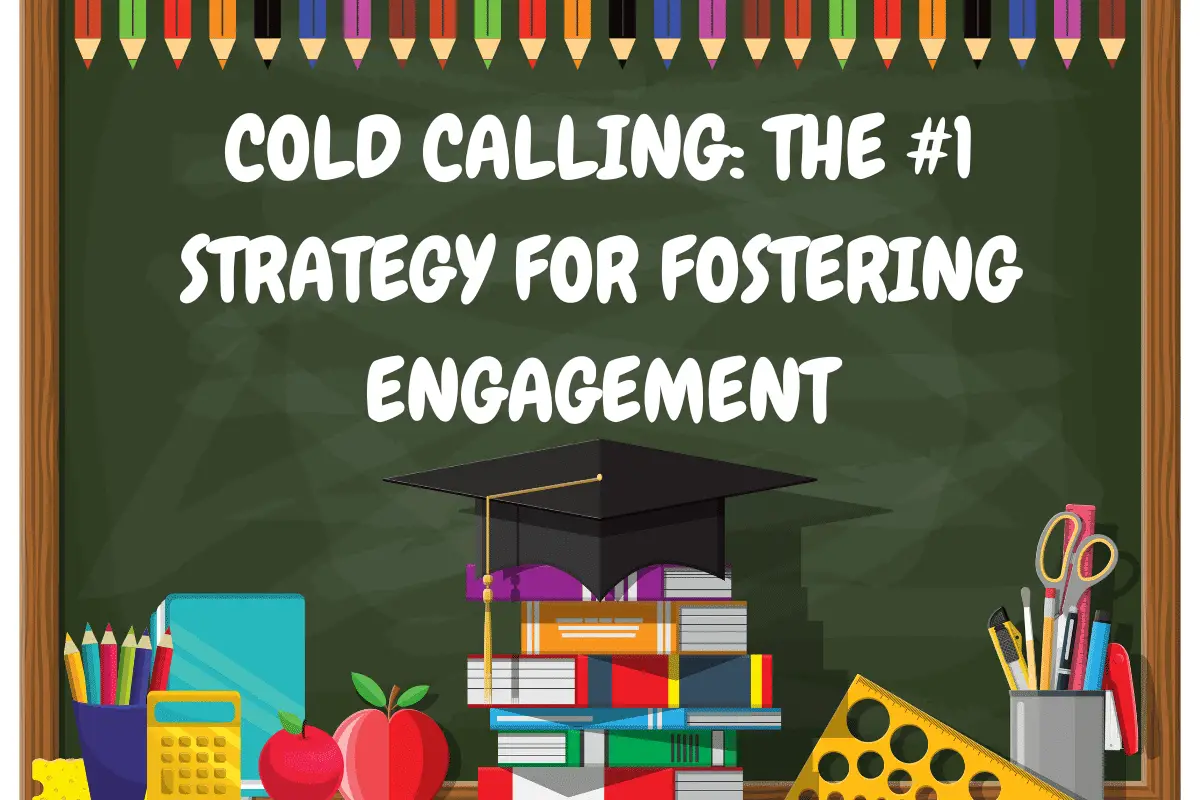
About The Author
I'm Dan Higgins, one of the faces behind The Teaching Couple. With 15 years in the education sector and a decade as a teacher, I've witnessed the highs and lows of school life. Over the years, my passion for supporting fellow teachers and making school more bearable has grown. The Teaching Couple is my platform to share strategies, tips, and insights from my journey. Together, we can shape a better school experience for all.

Join our email list to receive the latest updates.
Add your form here
7 Reasons Why Education Should Be Free
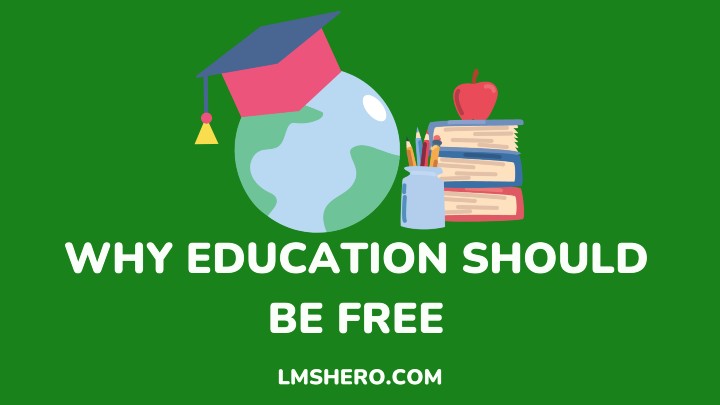
Besides being the cornerstone of success in a society, many barely understand why education should be free. This blog post covers that and more.
Education is the only mechanism available to you that allows you to shape your life. It is the most powerful weapon you can take up in the fight against ignorance. Unfortunately, it is mostly used as a tool for economic gain.
The rise in the cost of education is one of the biggest problems to hit our world today. The rising costs make it even harder if you have limited means to get educated and compete with those who can afford it.
This post views reasons why education should be free, and how it helps develop society while improving your standard of living.
What is Free Education?
Free education is education without economic cost , tuition, fees, or other products. You could also define it as one controlled or completely funded by the state, free of charge, or free to all students.
Over the past decade, small but devoted groups of people have worked together to make education accessible to everyone. After all, education should be free because it helps you develop your abilities and take part more in society.
Also, free education means expanded access to education by everyone. So, instead of education being available to certain people based on social status, it expands to everyone to ensure that they can attend for free.
Free schooling should always be available to everyone, not fee-based as with most universities and colleges.
What are the Importance of Free Education?
The idea of free education is growing around the world as more and more people realize the importance of free schooling. Some countries provide free education for their citizens, but it is not as common as it should be.
However, free education helps create a better and more productive future for people around the globe. Also, it provides you with the knowledge needed to succeed and allows you to take on challenges with confidence.
1. Education Empowers People to Be Agents of Change
Education empowers us to be agents of change. It is the only sustainable force for global progress and social justice. It should be free because it is also a human right that goes beyond school.
Quality education also extends to you learning beyond the classroom through life experiences.
Also, education is important to create real, sustainable change in the world. It equips you with knowledge and building capacity for marginalized or oppressed individuals. Access to free education can also make positive changes toward a more fair world.
2. It Will Stop the Brain Drain
Brain drain is the migration of skilled workers from one region to another in search of quality life and better standards of living. This includes better education, higher salaries, better healthcare, access to state-of-the-art technology, and better security.
More educated people will stop the brain drain. The human capital theory describes how knowledge is always of value to everyone. This means that if you have acquired knowledge, you hold more value than an ordinary person.
Hence, access to free education leads to an increase in skilled workers available in your country. A country with more skilled workers will not suffer from brain drain when some move in search of greener pastures.
3. It Increases the Choices Available to Learners
Free education increases the choices available to learners and reduces the barriers we currently face. The goal of education should be to free us from a controlled and scheduled curriculum and not to limit or define our thinking and creativity.
4. Education Is a Basic Human Right
Education being a human right is a statement confirming that it should be available to all without restriction due to financial, cultural, linguistic, or gender disparities.
Also, education is a basic right because it is a form of human capital that facilitates capacity building and opportunities in life. It also allows you to live a fulfilling and productive life.
In modern times, uses of this right may include public literacy programs, public libraries, open universities, and free Internet resources .
What are the Benefits of Free Education?
Education should be free and accessible for every individual.
There’s no better way to have the tools and skills needed to succeed in today’s ever-changing world than through higher education. If the government doesn’t invest in human capital, we will end up with a workforce lacking vital job skills.
Also, an under-educated population will bring down the economy. While educational platforms like Coursera and Udemy help by offering free courses to people, more can be done to make it a reality.
Below are some reasons why access to free education is crucial.
1. Access to Free Education Increases Your Opportunities
By removing the financial barrier to education, everyone can enjoy all the gifts and benefits education can offer. Free education will break the poverty cycle and give people the power to get out of poverty.
2. It Reduces Inequality
Education should be for everyone, despite your financial position. After all, education contributes to success and equality and increases your chances of prospering in a nation.
Through free education, you will get the same amount of knowledge as others with higher societal standards. You also won’t have to live with such a big gap between you and those who attend expensive institutions.
3. Free Education Leads to Lower Crime Rates
The argument that a more educated society has fewer crimes is one of the most popular arguments for free public education.
Studying improves human behavior and reduces government costs on law enforcement. This also means lesser costs on damage repairs caused by criminals.
Also, two-thirds of juvenile crimes are from people who lack a high school diploma or proper education.
4. Free Education Helps Develop the Economy
Education allows a country to grow economically as it becomes more educated. Education equips you with the skills to work in the job market, from entry-level jobs to higher-paying jobs.
The more skilled labor that exists in a country, the more economic growth that country experiences.
5. Free Education Attracts Tourists
If education is free in a country, that country records a rise in tourists coming to enjoy the top-notch education system. This in turn leads to diversity and economic growth.
6. It Helps Prevent Conflict
While education is the key to any nation’s success, the lack of access to education leads to ignorance and the rise of conflicts.
Yet, when proper education is free and available for all, we can better handle social and political problems. It also helps us live together peacefully.
7. Free Education Means More Better-Educated Employees
Education promotes critical thinking, creative development, public speaking, and resourcefulness.
These skills help businesses to thrive and develop. So not only does free education create informed workers, but it also creates a higher level of understanding among you and your colleagues.
Businesses benefit by hiring educated staff who are smarter and more productive than uneducated ones.
What Are the Challenges Facing Free Education?
Challenges facing the actualization of free learning include inadequate facilities, systematic corruption, and insufficient funding.
Also, inadequate support from the community, negligence from the government, and a high level of insecurity contribute to the challenges faced.
Free education finance is a long-term problem for governments worldwide. These challenges make it difficult for most countries to effect free schooling in the system, as their attention is usually diverted.
Corruption within the system and among the politicians in power also makes the implementation of free education a hard task to perform.
Ways to tackle the challenges facing free education include:
- Combating corruption in the system.
- By preventing acts of terrorism and insecurity that cause damage to infrastructure.
- Allocating more funds to the education sector.
- By helping communities provide more support to combat illiteracy in society.
Examples of Countries with Free Education Systems
Ideally, the education system should be fair. The rich should not live a better life through education simply because they can afford it.
There are several countries where you can find free higher education such as:
How does education improve your life?
Education helps you by building your knowledge, improving your abilities, and getting you a good job. It also helps in making a decent living and in bringing an overall improvement in your lifestyle.
Why is education so expensive?
One key reason is educational bureaucracy.
Modern education models are set up to be extremely bureaucratic with different entities controlling various aspects of education. This can stifle innovation and give rise to corruption at all levels of the ecosystem.
How does the high cost of education affect your standard of living?
It becomes harder for you to have a complete education when schools charge higher fees. While this might not affect people of higher social status, it affects the common man.
As a result, you may have to take out student loans or work many jobs to pay for your education.
What is the greatest advantage of free education?
The greatest advantage of free education is that it is available to all who need it.
A lot of us are not given the chance to receive higher education due to its high cost. However, if education is available to everyone, everyone would have a shot at getting a good job that pays well.
Also, as a business owner who is better educated, you make wiser decisions for yourself and your employees.
Your employees will also be more informed about the way they work because of their ability to understand. This means that you and your staff can improve the business, maximize profits, and help people.
Does lack of access to free education lead to poverty?
Yes, the lack of affordable or free education leads to poverty for the majority.
Education is perhaps the cornerstone for both children and adults of the future. Because most parents do not have that much money to pay for their child’s education, a college education is often neglected.
Furthermore, as a result of this inability to afford an education, a good job is out of reach leading to poverty. This is a circumstance that no one deserves.
A lack of proper education means limitations to most high-paying jobs. It also means more turn to a life of crime in other to get a better life.
Education is a powerful and important tool for shaping the world. It empowers you and sets you free, allowing you to do anything you want to do in life.
Unfortunately, education is not currently free in most countries but is a business. And like all businesses, education serves to make money.
Effective education should not be a luxury for the rich, it is a necessity in any society, in any culture, and in any country. Also, education isn’t just a workplace skill—it’s an economic and societal driver. It breeds success and helps families succeed.
Additionally, education leads to new careers, higher wages, a secure society, innovation, tolerance, better healthcare, improved law enforcement, and much more.
Finally, free education should not be a charity, but rather an investment in human capital. I believe this will lead to economic growth and societal development.
You should also read more about why education is important to society . You will be convinced of the benefits of free learning if you read this.
I hope you found this post helpful. Thanks for reading.
You may also like:
- Top 11 Reasons Why Education Is Important to Society
- 10 Major Purposes of Education
- What Is Life Skills Education: Importance, Challenges, & Categories
- Benefits Of Education: Why Education Is Important
- A Guide to Liberal Education
People Also Read:

Why Do Waiters Get Paid So Little [+ How To Make More Money]

Navigating Workplace Norms: Can You Email A Resignation Letter?

Difference Between Roles And Responsibilities

Does Suspension Mean Termination?

Moral Claim: Definition, Significance, Contemporary Issues, & Challenges

Why Can’t You Flush The Toilet After A Drug Test?


2 Minute Speech On Education Should Be Free In English
Good morning everyone present here, today I am going to give a speech on education should be free. Because not everyone can afford it, education should be free for all because it is the cornerstone of our successful future. Fees for colleges and universities are too expensive today. Children that wish to learn are unable to do so. This issue affects plenty of families. Parents were distraught and contemplating their options, including how to obtain high-paying employment and avoid disappointing a child.
They entered the workforce at a young age without any training or experience. As you could have guessed, they had no accomplishments. People, therefore, require free education in order to succeed. India’s government must make education free in order to unify and spread the country’s educational system.
Every child has the right to an education, but not every child is born into a stable family. As members of the postmodern age of civilized and educated people, we can do our part by establishing private institutions where we can give the slum kids in our area free instruction. These modest alterations could trigger more significant ones across a wider range.
In addition to allowing private companies to manage educational institutions, the Indian government should offer free education to assist poor families. Wealthy families who want their children to receive a top-notch education can enroll them in private schools. When competing with private firms, government-owned firms would result in high-quality service delivery. Thank you.
Related Posts:
- Random University Name Generator
- Michael Poem by William Wordsworth Summary, Notes and Line by Line Explanation in English
- Random Idiom Generator
- The Last Visit Poem by Taufiq Rafat Summary, Notes and Line by Line Explanation in English
- What is Digital Humanities and What is it Doing in English Departments Summary
- The Child is not Dead Poem by Ingrid Jonker Summary, Notes and Line by Line Explanation in English for Students

Search Icon
Events See all →
Vahe sarkissian.

World Cafe Live, 3025 Walnut St.
Dangerous Waters
Meyerson Hall, 210 S. 34th St.
WXPN 24-Hour Song Challenge

Wawa Welcome America Day

10:00 a.m. - 5:00 p.m.
Penn Museum, 3260 South St.
Campus & Community
The importance of free speech on college campuses
Running penn’s committee on open expression has given sigal ben-porath an up-close look at free speech on campus—and even inspired her to write a book on the topic..

Sigal Ben-Porath , a professor at the Graduate School of Education , has been chair of Penn ’s Committee on Open Expression since the 2015-16 academic year, a position that has given her an up-close and personal view of the complications and challenges surrounding free speech, especially in the current, hyper-partisan environment.
Consisting of faculty, staff, and students , the Committee follows Penn’s longstanding Guidelines on Open Expression , which were developed in the 1960s and updated a number of times in subsequent years. Members of the Committee are tasked with upholding the Guidelines and mediating related concerns that are brought before them.
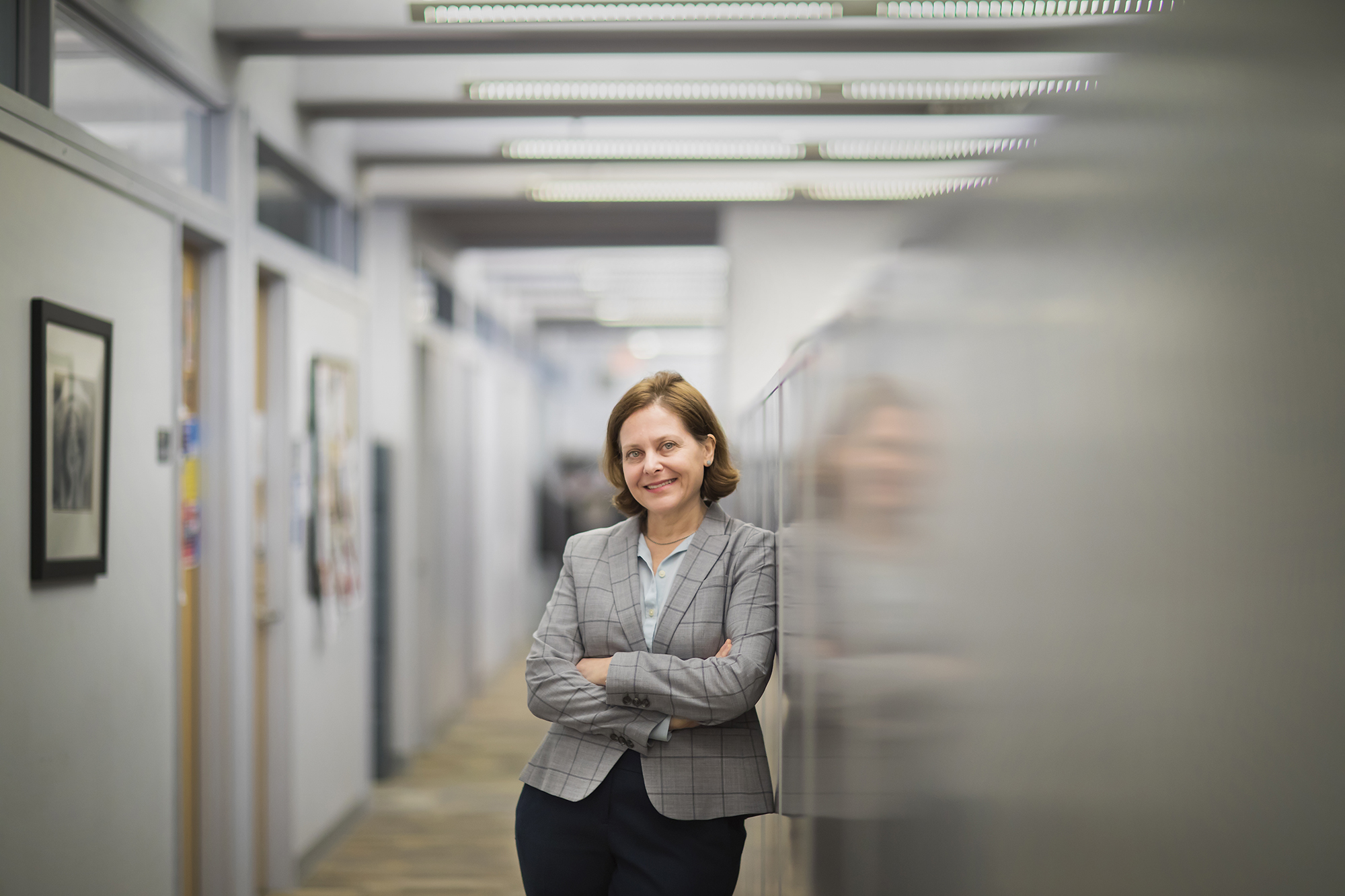
Since the 2015-16 academic year, Sigal Ben-Porath has been chair of Penn’s Committee on Open Expression.
Devotion to an open-minded atmosphere on college campuses has been embraced, by and large, by students and faculty for generations, says Ben-Porath, who both believe freedom of expression is imperative for constructive learning and research. Nonetheless, she says students with diverging ideological leanings differ on how free freedom of speech actually is. Certain students believe the right is nearly absolute; others seek to limit debate or the expression of views on topics they believe fall outside the bounds of reasonable discussion.
Ben-Porath’s work on the Open Expression committee moved her to write the book “Free Speech on Campus.” Published last year by the University of Pennsylvania Press , the manuscript examines the current state of the arguments about free speech on college campuses, using real-world examples to explore the contexts in which conflicts and tensions erupt.
In response to her book, Ben-Porath has been invited to give talks about free speech at a variety of higher education institutions, including community colleges, Ivy League universities, and public institutions, some of whom have set up committees to draft or update guidelines on open expression.
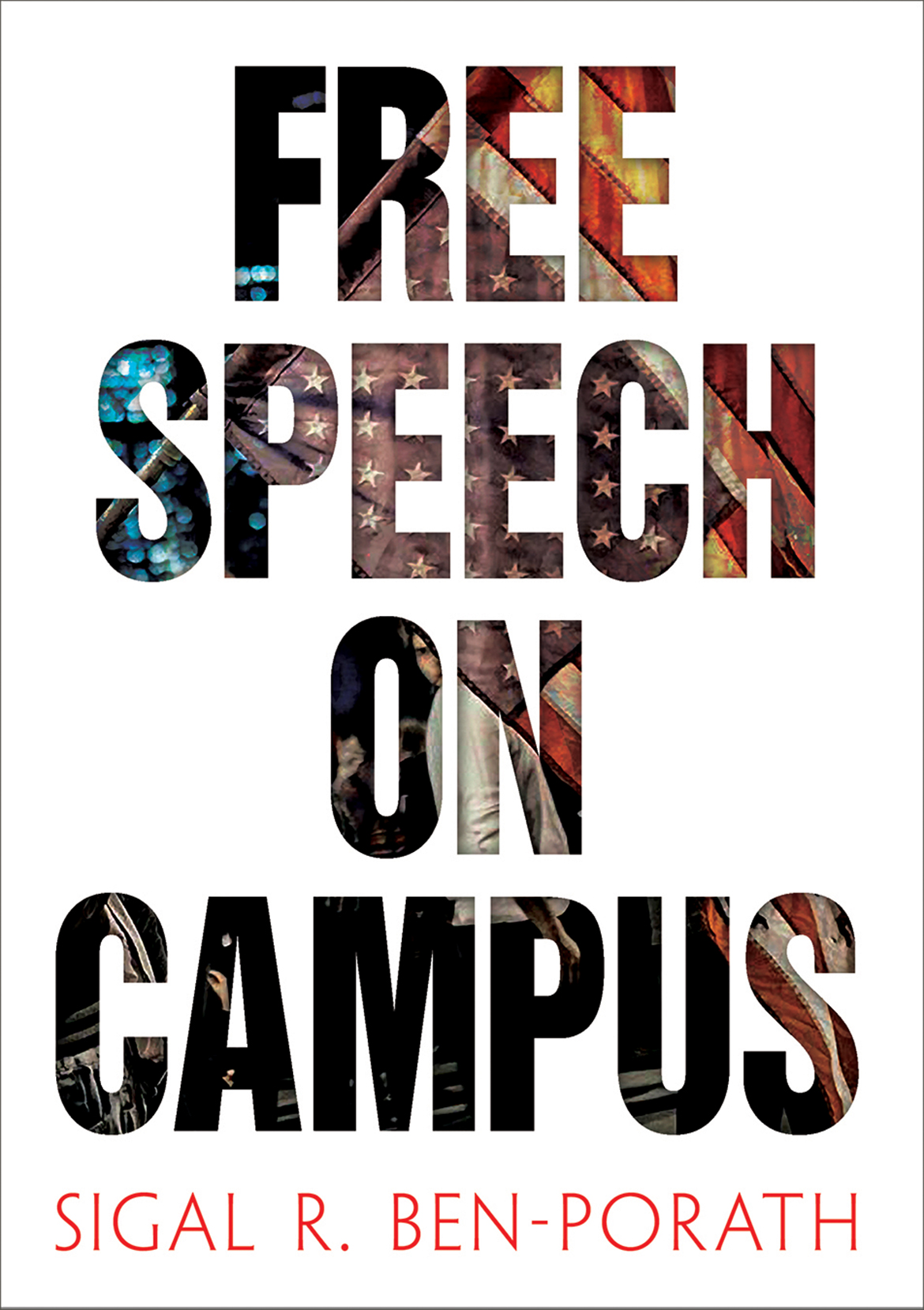
“Free Speech on Campus” was published last year by the University of Pennsylvania Press.
“I think a lot of places are just now waking up to the concern that even if you’re a small place, even if you don’t necessarily see yourself as that visible or your students as necessarily organized in this way, it’s still your problem as well,” she says. “Even if you’re not interested in free speech, free speech is interested in you.”
Administrative awakenings in relation to free speech on college campuses are the result of student activism, and also the fact that universities are a primary target in the current culture wars, Ben-Porath says. University leaders have trepidations about how the higher education sector is perceived. She says where a person stands on the issue of free speech on college campuses is now a marker for a general ideological stance that partisans can use to signal their overall position, similar to how people used to speak about marriage equality.
The most vocal critics accuse universities of being too elitist, lacking ideological diversity, and prioritizing progressive and liberal views.
Commentators and critics point to instances in which conservative speakers have been heckled or prevented from speaking as proof that students at so-called “liberal” universities are too fragile for ideological debate, fail to understand democratic commitments, and are attempting to stifle free speech.
Surveys have shown a more limited support for free speech or First Amendment protections on college campuses, but Ben-Porath says students attempting to limit speech support free speech, but object to free speech being used to harm, denigrate, or devalue another human being.
“This is not being a snowflake, this is being an activist,” she says. “What they are expressing is not oversensitivity that they can’t handle the truth. They are expressing a commitment to the values that we are teaching them and we are not always practicing, like equal dignity to all persons. That doesn’t show fragility, in my view. It actually shows a commitment to democratic values, and we need to listen to that.”
Even if you’re not interested in free speech, free speech is interested in you.
Sigal Ben-Porath, a professor in the Graduate School of Education
Ben-Porath does not support speech codes or the shutting down of speakers—even those who speak hate. Universities as an institution should not invite such speakers, but if a student or a student group is interested in inviting the person to campus, she does not think the school should intervene.
Aside from individuals calling for violence, Ben-Porath says there are very few people who should be prevented from speaking.
“From where I stand, it’s going to be a pretty small marginal group of people, and I won’t expand it, even when there are people who I see and a lot of people see as quite hateful,” she says. “I don’t necessarily want to prevent them from coming to campus because I think that they are, sadly, a part of our current political debate. I regret that, but I would like to support my students in engaging with that.”
Student activists have a large toolkit for responding to speakers they disagree with if they look historically and in present practice, Ben-Porath says. And these tools are much more effective than shutting speakers down. She says students can use humor, as has been done when responding to the anti-gay preachers on Locust Walk. To protest the preachers’ hateful signs, students created their own humorous signs and collected donations for the Attic, an LGBT youth center, while the preachers spoke.
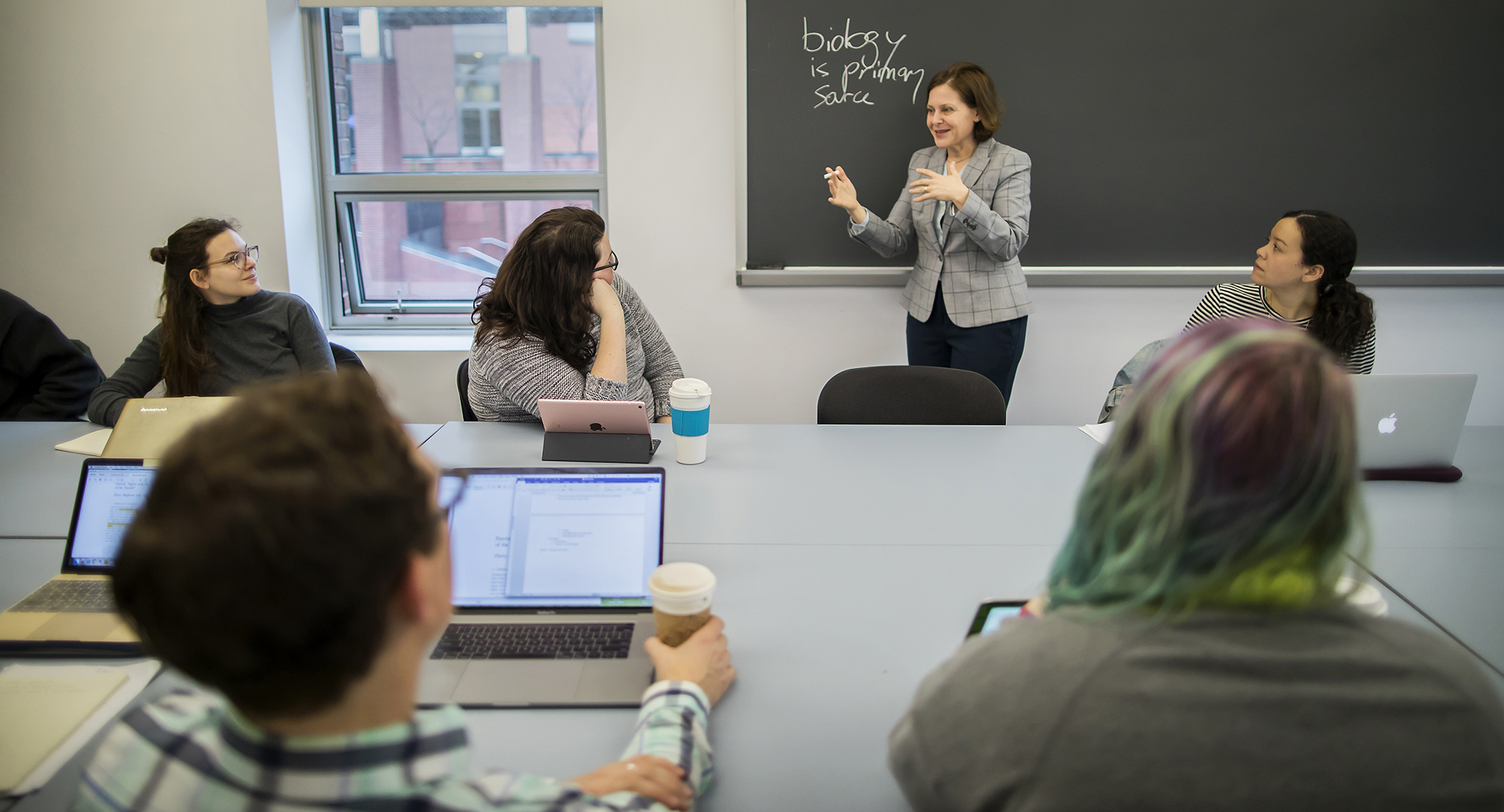
“The Black Graduate and Professional Student Assembly here on campus staged an excellent protest earlier this fall in response to a speaker speaking against the Black Lives Matter movement,” Ben-Porath says. “Excellent in the sense that it was nonviolent, but a very effective protest.” The students dressed in similar fashion, brought signs expressing their opposition, asked the speaker hard questions, and protested outside the venue.
“They engaged with the content and rejected it effectively,” she says. “They engaged with the actual invitation by their presence, by their visible appearance with their clothes and their signs. I thought that was great because they were able to express their opposition, and to express their valid perspective in opposition to her views way more effectively than if they shouted her down.”
Photo: Ben-Porath’s research focuses on citizenship education, normative aspects of educational and social policy, and the social and educational effects of war.
To Penn’s Class of 2024: ‘The world needs you’

Class of 2025 relishes time together at Hey Day
An iconic tradition at Penn, third-year students were promoted to senior status.
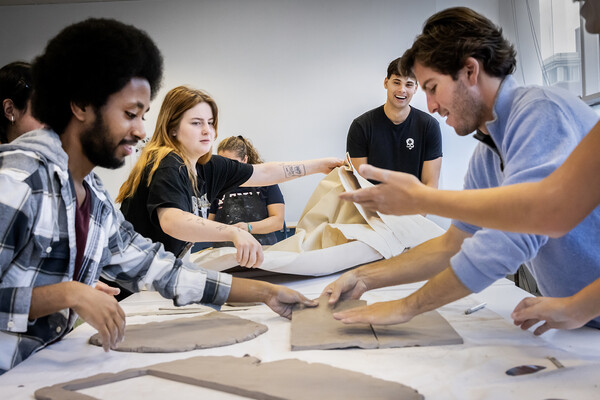
Arts, Humanities, & Social Sciences
Picturing artistic pursuits
Hundreds of undergraduates take classes in the fine arts each semester, among them painting and drawing, ceramics and sculpture, printmaking and animation, photography and videography. The courses, through the School of Arts & Sciences and the Stuart Weitzman School of Design, give students the opportunity to immerse themselves in an art form in a collaborative way.

Penn celebrates operation and benefits of largest solar power project in Pennsylvania
Solar production has begun at the Great Cove I and II facilities in central Pennsylvania, the equivalent of powering 70% of the electricity demand from Penn’s academic campus and health system in the Philadelphia area.

Education, Business, & Law
Investing in future teachers and educational leaders
The Empowerment Through Education Scholarship Program at Penn’s Graduate School of Education is helping to prepare and retain teachers and educational leaders.
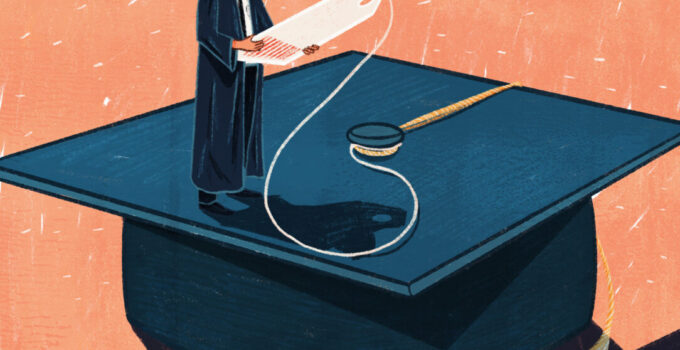
Speech on Free Education for Everyone
A good education is essential for self-development and development of societies. Schooling helps us read and write, learn basics, and develop new skills. Here’s a collection of short speeches on free education for everyone.

Free Education for Everyone
Speech on Free Education
When we look at the corners of the world today, we can see children attending classes, learning, and progressing. However, in some countries education is not free, which can lead to kids being kept out of school. According to UNICEF, families in many countries in the rest of the world that lack good access to schooling struggle to pay fees to send their kids to school.
“In Uganda and Nepal, households provide a half of the education funding: 57 percent and 49 percent, respectively.”
http://uis.unesco.org/ claims other countries such as Côte d’Ivoire the coverage is a third (33 percent). The study includes costs for items such as school uniforms, textbooks, tuition, and other costs. Even in primary school, the costs are high, ranging from $87 a year in Ghana to over $670 in El Salvador.
The concern is parents of developing countries pay a much larger percentage of their income on education than parents from developed nations. The outcome, the UNICEF study claims, is this stops parents from sending children to school. The knock on effect allows for grim reading, for the family becomes trapped in a cycle of poverty. The child does not learn new skills and then uneducated, finds it hard to gain employment in a decently paid job.
The struggle to educate children in developing countries becomes harder when the child reaches secondary school age. Secondary spending reaches up to 25% of a household’s entire yearly income in Côte d’Ivoire, Guinea, Chad, and Niger according to the UNICEF report.
“Households in Africa’s Benin spend more per secondary student ($402) than the government ($259).”
Developing countries should spend more to make education a priority and make it easier for all families to benefit from free education. School provides an environment where we can learn many basic skills. We learn the alphabet, numbers, and maths. We also get the chance to practice social skills, teamwork, drawing, building, problem-solving and cognitive skills.
The skills and knowledge that we learn at school will help us now and in later life as we find employment. Good attendance and exam results show potential employers that we are reliable.
Benjamin Franklin was one of the Founding Fathers of the United States and a leading writer, printer, inventor, political philosopher, politician, Freemason, postmaster, scientist, humorist, civic activist, diplomat and statesman. His famous quote about the importance of education is as powerful now as it was in the 18 th century:
“An investment in knowledge pays the best interest.”
Michelle Obama reinforced how education is of key importance:
“The ability to read, write, and analyze; the confidence to stand up and demand justice and equality; the qualifications and connections to get your foot in the door and take your seat at the table—all of that starts with education.”
2. Free Education
What are we if we never attend school? What prospects do we have individually and as uneducated societies? The prospects are bleak. Attending school allows us to learn to read and write. With neither we would not be able to aptly communicate ideas and knowledge. At school we learn good hygiene in home economics and how to prepare food. At school we learn about lessons of history and how our forbears strived to make our countries safer, fairer, well supplied with food, clean water and medical advancements to safeguard our health. It was Winston Churchill who underpinned the importance of learning history when he said:
‘From history we learn the prognosis of future events’.
By going to school we learn about the importance of team work and how to assign workplace roles and responsibilities for a better outcome. At classes we learn about the importance of mathematics and how it helps us build great structures, transport and solve engineering problems. Education allows us to learn the arts: the techniques of the great oil painters of the past, the writings of learned men such as William Shakespeare. A more light hearted quote was breathed by Marcus Tullius Cicero (106 BC – 43 BC) who is often considered as one of the greatest Roman orators and prose stylists of his time. He wisely said:
“If you have a garden and a library, you have everything you need.”
When financial costs become too high parents in developing countries opt not to send their children to school. The outcome is a spiral of ignorance and poverty.
I will now speak of the countries that deserve plaudits by offering free education. Higher education tuition fees are free in Norway allowing students to earn degrees at high quality universities such as Oslo, the University of Bergen and the Norwegian University of Science and Technology.
Students pursuing research-based doctoral degrees get free tuition in Sweden. Of high merit comes Germany. It’s need for technical workers has opened the doors to free higher education to all students. Highly esteemed institutions, such as the University of Munich and University of Bonn, mean that students receive a good education.
Beyond Europe public universities in countries such as Mexico and Brazil also have virtually free tuition which needless to say is great for encouraging new generations to attend universities. Small registration fees are payable, though do not add up to much.
According to Business Insider the percentage of young adults who will attend university in Norway is predictably very high at 77%.
According to a 2011 report from OECD, when you add up the cost of living, tuition, books and other expenses, the average cost of attending a US in-state public university can total $25,290 a year. That figure must have only grown.
The National Center for Education Statistics (NCES) is the primary federal entity for collecting and analyzing data related to education in the U.S. claims a 2017 study found t he overall college enrollment rate for young adults increased from 35 % in 2000 to 40 % in 2017, with Asian ethnic groups at 65% attendance rate while white and black were much lower at %45 and 35% respectively.
All said, I have laid down reasons why it is a modern day crime for some developing countries and developed nations not to invest more in free education for everyone or at least to make it affordable.
If you have the opportunity to attend school and later college you should grasp the opportunity to improve your skills, learn knowledge and progress to a well paid job.
Related Posts

Are IQ Tests a Valid Measure of Intelligence?


6 Essay Writing Mistakes Many Students Make in 2024

How to Select Platforms for NEET Coaching?
About the author.
FindaSpeech
What you need to know about the right to education
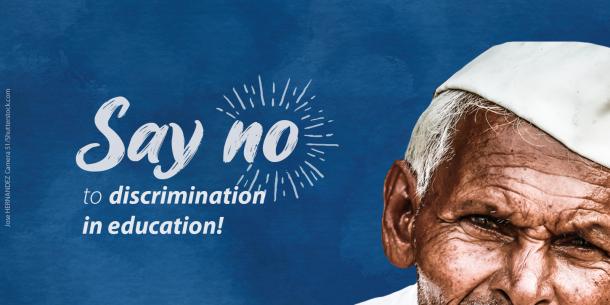
The Universal Declaration of Human Rights affirms that education is a fundamental human right for everyone and this right was further detailed in the Convention against Discrimination in Education. What exactly does that mean?
Why is education a fundamental human right?
The right to education is a human right and indispensable for the exercise of other human rights.
- Quality education aims to ensure the development of a fully-rounded human being.
- It is one of the most powerful tools in lifting socially excluded children and adults out of poverty and into society. UNESCO data shows that if all adults completed secondary education, globally the number of poor people could be reduced by more than half.
- It narrows the gender gap for girls and women. A UN study showed that each year of schooling reduces the probability of infant mortality by 5 to 10 per cent.
- For this human right to work there must be equality of opportunity, universal access, and enforceable and monitored quality standards.
What does the right to education entail?
- Primary education that is free, compulsory and universal
- Secondary education, including technical and vocational, that is generally available, accessible to all and progressively free
- Higher education, accessible to all on the basis of individual capacity and progressively free
- Fundamental education for individuals who have not completed education
- Professional training opportunities
- Equal quality of education through minimum standards
- Quality teaching and supplies for teachers
- Adequate fellowship system and material condition for teaching staff
- Freedom of choice
What is the current situation?
- About 258 million children and youth are out of school, according to UIS data for the school year ending in 2018. The total includes 59 million children of primary school age, 62 million of lower secondary school age and 138 million of upper secondary age.
155 countries legally guarantee 9 years or more of compulsory education
- Only 99 countries legally guarantee at least 12 years of free education
- 8.2% of primary school age children does not go to primary school Only six in ten young people will be finishing secondary school in 2030 The youth literacy rate (15-24) is of 91.73%, meaning 102 million youth lack basic literacy skills.

How is the right to education ensured?
The right to education is established by two means - normative international instruments and political commitments by governments. A solid international framework of conventions and treaties exist to protect the right to education and States that sign up to them agree to respect, protect and fulfil this right.
How does UNESCO work to ensure the right to education?
UNESCO develops, monitors and promotes education norms and standards to guarantee the right to education at country level and advance the aims of the Education 2030 Agenda. It works to ensure States' legal obligations are reflected in national legal frameworks and translated into concrete policies.
- Monitoring the implementation of the right to education at country level
- Supporting States to establish solid national frameworks creating the legal foundation and conditions for sustainable quality education for all
- Advocating on the right to education principles and legal obligations through research and studies on key issues
- Maintaining global online tools on the right to education
- Enhancing capacities, reporting mechanisms and awareness on key challenges
- Developing partnerships and networks around key issues
How is the right to education monitored and enforced by UNESCO?
- UNESCO's Constitution requires Member States to regularly report on measures to implement standard-setting instruments at country level through regular consultations.
- Through collaboration with UN human rights bodies, UNESCO addresses recommendations to countries to improve the situation of the right to education at national level.
- Through the dedicated online Observatory , UNESCO takes stock of the implementation of the right to education in 195 States.
- Through its interactive Atlas , UNESCO monitors the implementation right to education of girls and women in countries
- Based on its monitoring work, UNESCO provides technical assistance and policy advice to Member States that seek to review, develop, improve and reform their legal and policy frameworks.
What happens if States do not fulfil obligations?
- International human rights instruments have established a solid normative framework for the right to education. This is not an empty declaration of intent as its provisions are legally binding. All countries in the world have ratified at least one treaty covering certain aspects of the right to education. This means that all States are held to account, through legal mechanisms.
- Enforcement of the right to education: At international level, human rights' mechanisms are competent to receive individual complaints and have settled right to education breaches this way.
- Justiciability of the right to education: Where their right to education has been violated, citizens must be able to have legal recourse before the law courts or administrative tribunals.

What are the major challenges to ensure the right to education?
- Providing free and compulsory education to all
- 155 countries legally guarantee 9 years or more of compulsory education.
- Only 99 countries legally guarantee at least 12 years of free education.
- Eliminating inequalities and disparities in education
While only 4% of the poorest youth complete upper secondary school in low-income countries, 36% of the richest do. In lower-middle-income countries, the gap is even wider: while only 14% of the poorest youth complete upper secondary school, 72% of the richest do.
- Migration and displacement
According to a 2019 UNHCR report, of the 7.1 million refugee children of school age, 3.7 million - more than half - do not go to school.
- Privatization and its impact on the right to education
States need to strike a balance between educational freedom and ensuring everyone receives a quality education.
- Financing of education
The Education 2030 Agenda requires States to allocate at least 4-6 per cent of GDP and/or at least 15-20 per cent of public expenditure to education.
- Quality imperatives and valuing the teaching profession
Two-thirds of the estimated 617 million children and adolescents who cannot read a simple sentence or manage a basic mathematics calculation are in the classroom.
- Say no to discrimination in education! - #RightToEducation campaign
Related items
- Right to education
HerAtlas: Monitoring the right to education for girls and women HerAtlas: Background, rationale and objectives 12 March 2024
HerAtlas: Monitoring the right to education for girls and women HerAtlas: Disclaimer and terms of use 12 March 2024

Other recent news

Knight Foundation
- Communities
- Learning and Impact
- Philadelphia
- Community Foundations Program
- Press Releases
- Arts and Technology
- Diverse Asset Managers
- Elections and Voting
Freedom of Expression
- Knight Research Network
- Local Journalism
- Public Spaces
- Smart Cities
- Technology and Democracy
- Trust in News
- Board of Trustees
- Internship Program
- Financial Information
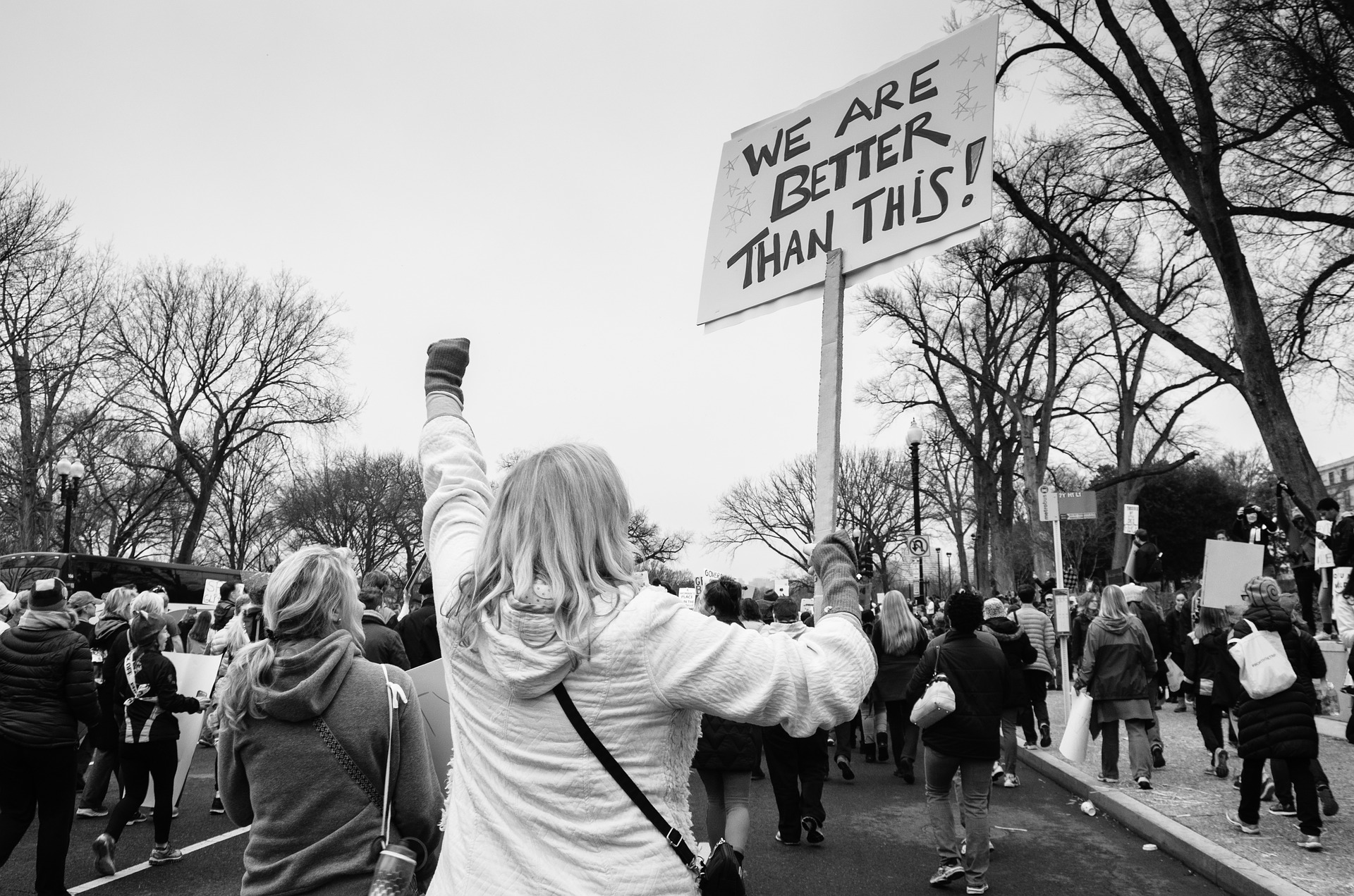
Colleges must better educate students on the value of free speech
On May 5, 2020, Gallup and Knight Foundation released a new report on college students and their attitudes about Free Speech. Robert Shibley shares insights below. View the full report and additional insights here.
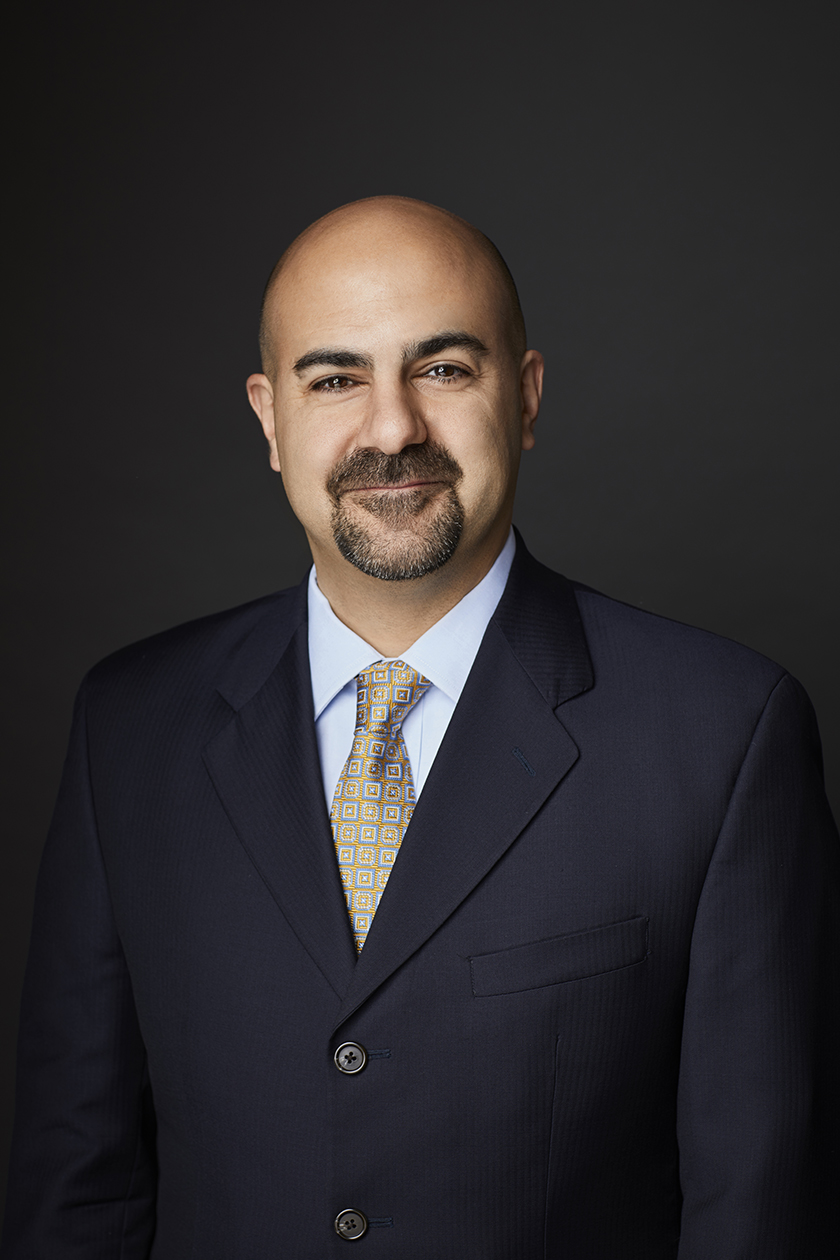
Are colleges and universities making progress in protecting students’ exercise of free speech and other First Amendment rights on campus? Despite an increase in concern about the issue in recent years — including a well-publicized executive order by President Trump that links federal funding to institutions’ agreeing to protect free speech — the recent Gallup-Knight First Amendment on Campus survey suggests that whatever campuses are doing to educate students about the First Amendment and their freedoms on campus isn’t working.
College students overwhelmingly say that they value free speech. When given the choice of whether it was more important to “protect students by prohibiting speech they may find offensive” or to “allow students to be exposed to all types of speech even if they may find it offensive or biased,” 81% of students surveyed said they favored the latter.
Yet their understanding of the limits of this freedom are restrictive compared to those established by law. Similarly overwhelming majorities support speech restrictions on campus when it comes to the use of offensive racial slurs (78%) or costumes that stereotype certain racial or ethnic groups (71%). A far lower but still concerning 26% would even back restrictions on “expressing political views that are upsetting or offensive to certain groups,” despite the fact that this could be said of virtually any political view, depending on who’s listening. Other questions reveal other aspects of willingness to limit peers’ speech.
It’s natural to have doubts about the utility of offensive speech. Indeed, to restrict speech widely considered offensive is the norm in human history. Blasphemy laws protecting sacred gods and ideals date to ancient times and are still in place in many nations today. Many Western democracies also restrict some speech that offends, or that they believe impairs the dignity of individuals or groups, though hardly on the scale of what was once the norm.
Only the most stubborn ideologue, though, would argue that the enormous increase in prosperity and progress that has taken place since the Enlightenment-era expansion of human rights and freedom is just some kind of coincidence. As Frederick Douglass famously observed, in condemning the antebellum South’s restrictions on speech about slavery, the right to speak is “the dread of tyrants. It is the right which they first of all strike down.” Censorship and repression have massive costs.
The modern American college campus may well be the place where restrictions on speech are least justifiable. Every student is a high school graduate or equivalent; those with criminal backgrounds are routinely excluded from attending. A college’s core is a community of scholars, all highly educated, whose very jobs consist of the pursuit of knowledge in an environment of reason. Universities provide recreational activities and other amenities to make students feel comfortable and cared for, often including police forces, medical clinics, and counseling centers separate from those of the general public.
Through taxpayer subsidies and often astronomical tuition bills, America has generously given colleges all they need, and more, to teach students and advance knowledge through open debate and the sifting and winnowing of ideas. Unfortunately, colleges are squandering their opportunities to serve our nation in this way by doing far too little to explain to students why free speech and academic freedom are so important.
When controversies arise over speech, teaching, and even research, colleges all too often throw principles by the wayside and find a reason to punish the offending student or professor. As it happens, the lesson that speaking your conscience can get you in trouble is one students definitely are learning: in the Gallup-Knight survey, 63% of students agreed that the climate on their campus prevents some people from saying things they believe because others might find them offensive, up from 54% in 2016.
Our students and our nation deserve better. Simple steps, such as eliminating unconstitutional or illiberal speech codes, making clear and principled statements in favor of free speech, and sticking to those principles when challenged, would cost nothing and make a big difference.
Efforts to educate students about the need for open discussion and academic freedom on campus — such as speakers, classes and orientation programs — would not cost much more. Colleges can and should make these changes now, so that the next Gallup-Knight poll has a chance to bring us some much-needed good news about the state of one of our nation’s most fundamental freedoms.
Robert Shibley is executive director of the Foundation for Individual Rights in Education (FIRE).
Photo (top) by StockSnap on Pixabay

The First Amendment on Campus 2020 Report: College Students’ Views of Free Expression

Free speech and the urban-rural divide on America’s college campuses

Free speech tensions include fear of what others might hear

Students are rejecting racist speech, not free speech
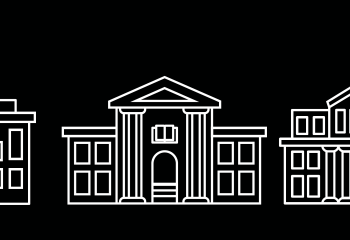
Campus Speech 2020: New survey reveals college student views on free speech and inclusivity

Universities must condemn hate speech without censorship
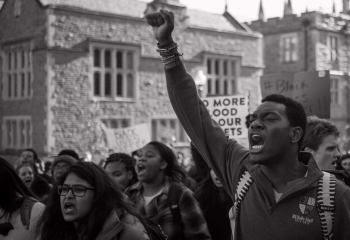
Sign up for our newsletter
Submit your email. Receive updates and the @knightfdn newsletter.
Recent Content

- Election 2024
- Entertainment
- Newsletters
- Photography
- Personal Finance
- AP Investigations
- AP Buyline Personal Finance
- AP Buyline Shopping
- Press Releases
- Israel-Hamas War
- Russia-Ukraine War
- Global elections
- Asia Pacific
- Latin America
- Middle East
- Election Results
- Delegate Tracker
- AP & Elections
- Auto Racing
- 2024 Paris Olympic Games
- Movie reviews
- Book reviews
- Personal finance
- Financial Markets
- Business Highlights
- Financial wellness
- Artificial Intelligence
- Social Media
US universities launch partnership to elevate free speech to counter threats to democracy
FILE - Graduates walk into High Point Solutions Stadium before the start of the Rutgers University graduation ceremony in Piscataway Township, N.J., on May 13, 2018. With the help of a nonprofit that focuses on civic education, the presidents of a wide-ranging group of 13 universities have decided to elevate free speech on their campuses this academic year. (AP Photo/Seth Wenig, File)
File - Graduates walk onto the field at Bridgeforth Stadium for the James Madison University commencement in Harrisonburg, Va., on May 5, 2017. With the help of a nonprofit that focuses on civic education, the presidents of a wide-ranging group of 13 universities have decided to elevate free speech on their campuses this academic year. (Stephen Swofford/Daily News-Record Via AP, File)
- Copy Link copied
The presidents of a wide-ranging group of 13 universities are elevating free speech on their campuses this academic year, as part of a new nonprofit initiative announced Tuesday to combat what organizers call dire threats to U.S. democracy.
The Campus Call for Free Expression will take different forms on different campuses. The campaign, created by The Institute for Citizens & Scholars with funding from the Knight Foundation is designed to cultivate the freedom of expression on campuses and help students work together to find solutions to complicated, divisive problems.
“The national context of the deep political polarization, the inability of people to speak across difference in constructive and civil ways, it seems to me that colleges and universities need to be the institutions at the forefront of showing a better way to do that,” said Jonathan Alger, president of James Madison University, which is participating in the initiative.
The Institute for Citizens & Scholars first convened a group of college presidents in March 2022 to discuss how to prepare students to actively participate in democracy. Eventually, the presidents and schools committed to five principles of free expression along with new, on-campus programs that each school designed themselves. Those include new training at freshman orientations, faculty seminars and convocation remarks.

While not new, controversies around free speech at universities abound, from students protesting invited speakers to state legislatures targeting faculty tenure , and also reflect an increase in restrictions on freedom of speech more generally.
The participating schools include The University of Notre Dame, a private Catholic research school, Benedict College, a historically Black school in South Carolina, Rollins College, a small liberal arts school in Florida, and Ivy League member Cornell University, which in April announced that freedom of expression would be the theme for its 2023 school year. The other schools are Claremont McKenna College, DePauw University, Duke University, James Madison University, the University of Pittsburgh, The University of Richmond, Rutgers University, Wellesley College, and Wesleyan University.
Jonathan Holloway, president of Rutgers University in New Jersey and a historian of African American history, said he was motivated to join the initiative in part by what he called a growing deep disregard for American institutions.
“If I don’t speak up now on what I see that’s so concerning, if I don’t do this now, then when?” he asked, adding, “When I saw the Confederate battle flag marched through the Capitol Rotunda in January 2021, that’s when things shifted for me.”
This September, Holloway will lead a freshman course that will examine the meaning of democracy and ask students to help design a program for the university to improve civic education.
For Rajiv Vinnakota, president of the Institute for Citizens & Scholars, there are two main reasons to focus civic education on college students. For many, their colleges will be the most diverse community that they’ve ever experienced and students have the potential to shift social norms as they enter public forums and start to participate in politics. He hopes that the collective commitment of these schools to fostering critical thinking and the exchange of ideas around contentious issues will encourage other institutions to join them.
“Are we able to get above the cacophony of these issues of free expression to be able to get people in general (and) leaders to be able to see that higher ed can and should play a leading and proactive and positive role in civic preparedness?” Vinnakota asked.
The Knight Foundation provided a $250,000 grant to the institute to convene the presidents and eventually other university staff in a series of conversations over a year and a half.
“We believe in the free exchange of ideas. We believe in an informed citizenry so that the people may determine their true interest,” said Alberto Ibargüen, president of the foundation.
The nonprofit PEN America offers training to colleges and universities around cultivating an exchange of ideas as part of its work advocating for human rights and free speech. In general, Kristen Shahverdian, senior manager of its Free Expression and Education program, said that showing students why protections for free speech matter is an effective way to win over them to hearing about opposing views.
“When students learn about how writers and artists around the world have been persecuted for their free expression, they understand the ramifications of squashing another’s speech,” she said in response to emailed questions.
James Madison University is partnering with the Bipartisan Policy Center to host a training for more than 4,000 incoming students this year to prepare them for free expression on campus. The training will ask the students to participate in real time through a survey application and the school will also use their responses to help design future trainings. JMU already surveys new students about their civic engagement and repeats the assessment in their third year to measure student learning.
Lucas Morel, a professor of politics at Washington and Lee University and chair of the Academic Freedom Alliance, said more universities and colleges should embrace a mission of cultivating the pursuit of knowledge through the airing of different ideas and arguments based on evidence. A college education is not just meant to help students get a job or gain knowledge, but also to help make them engaged citizens, he said.
“If we don’t do a good job of helping them be careful readers and careful listeners, it stands to reason that as citizens they won’t be careful listeners and careful expressors of their own thought,” he said. “And it will be difficult for us to function as a self-governing society.”
This story has been corrected to show the attack on the U.S. Capitol occurred in January 2021.
Associated Press coverage of philanthropy and nonprofits receives support through the AP’s collaboration with The Conversation US, with funding from Lilly Endowment Inc. The AP is solely responsible for this content. For all of AP’s philanthropy coverage, visit https://apnews.com/hub/philanthropy .
Is free college a good idea? Increasingly, evidence says yes
Subscribe to the brown center on education policy newsletter, douglas n. harris douglas n. harris nonresident senior fellow - governance studies , brown center on education policy , professor and chair, department of economics - tulane university @douglasharris99.
May 10, 2021
- 10 min read
In just a few short years, the idea of free college has moved from a radical idea to mainstream Democratic thinking. President Biden made free college one of his core campaign planks , and one that the first lady has been promoting for years. In his recent address to Congress, the president also signaled that he is ready for legislative action on a scaled-back version of the idea as part of his American Families Plan .
Two weeks ago, the nonprofit College Promise (CP)—led by Martha Kanter, who served as President Obama’s undersecretary for education—also released a proposal that will influence the free college debate. (Full disclosure: I previously advised the Biden campaign and presently advise CP, but have received no compensation for these efforts.)
In today’s polarized environment, the free college idea stands out for its bipartisan support. A majority of self-identified Republicans has supported the notion of free college in some polls. In fact, one of the first such statewide programs was put in place by Bill Haslam, the former Republican governor of Tennessee. While this could go the way of Obamacare, which faced strong GOP congressional opposition despite the law’s origins with Republican Mitt Romney, free college seems different. Biden’s latest plan only applies to community colleges, which focus on career and vocational education of the sort Republicans support, as opposed to universities, which many Republicans view as hostile battlegrounds in a culture war.
But I am less interested in the politics than the evidence of effectiveness. I have studied college access for many years and run two randomized control trials of financial aid , which produced some of the first causal evidence on free college in Milwaukee. Two years ago, Brookings released the first installment of the Milwaukee work, which I carried out with a team of researchers. Since then, we have collected more data and learned more about how students responded over time. Below, I summarize our just-released study (co-authored with Jonathan Mills), compare our results to other financial aid programs, and then discuss implications for the Biden and CP proposals. Consequently, I conclude that the evidence increasingly favors free college and “open access aid” more generally.
What Did We Learn in Milwaukee?
I developed The Degree Project (TDP) in 2009 as a demonstration program in partnership between the nonprofit Ascendium (then known as the Great Lakes Higher Education Corporation and Affiliates) and Milwaukee Public Schools (MPS). TDP offered all first-time 9 th graders in half of MPS high schools $12,000 for college as “last-dollar” aid. Students could use the funds for college if they graduated from high school on time with a GPA of 2.5 and a class attendance rate of 90%. Also, as is the norm with free college programs, students had to fill out the FAFSA and have at least one dollar of unmet need. The aid could be used to attend any of the 66 public, in-state, two- or four-year colleges in Wisconsin. Ascendium provided up to $31 million to fund the grant and, as the main program administrator, sent regular letters to remind students about the program and its requirements. The organization also worked with school counselors to support students becoming eligible for the funds and preparing for college.
TDP was announced to students in the fall of 2011. Using anonymized data, we then tracked students’ high school, college, and life outcomes for eight years, and we recently received data extending through when students were roughly 22 years old. As a rare randomized trial, we could estimate the effects by comparing the control and treatment group outcomes. Here is what we found:
- For students who met the performance requirements, the program increased graduation from two-year colleges by 3 percentage points . This might seem small, but the denominator here is comprised of low-income 9 th graders. Half of the control group did not even graduate from high school, let alone college. The effect amounts to a 25% increase in two-year degrees.
- The framing and design of the program as free two-year college changed student decisions in ways consistent with what free college advocates suggest. The $12,000 maximum award amount was selected because it was sufficient to cover tuition and fees for a two-year college degree. The fact that TDP made two-year college free, but only reduced the cost of four-year college, was clearly communicated to students. This appears to explain one of our main results: Student enrollments shifted from four-year to two-year colleges. This is noteworthy given that students could use the funds at either two- or four-year colleges. In fact, students likely would have been able to use more of the $12,000 if they had shifted to four-year colleges. The only plausible reason for shifting to two-year colleges is that they were really attracted to the idea of free college.
- The “early commitment” nature of the program had some modest positive effects on some high school outcomes . Students learned about TDP in their 9 th grade year, giving them time to change their high school behaviors and college plans. Although it did not improve high school academic achievement, we find that TDP increased college expectations and the steps students took to prepare for college. TDP recipients also reported working harder because of the program (even though this did not show up in the academic measures). This highlights the fact that free college might also help address not only college-going rates, but the long-term stagnancy in high school outcomes.
- The merit requirements undermined the program’s effectiveness . Though the 2.5 GPA and 90% attendance and other requirements were arguably modest, only 21% of eligible students ended up meeting them. So, they ended up excluding many students. We also tested the two main ways that the merit requirements could have been helpful: (a) merit requirements might provide incentives for students to work hard during high school and better prepare for college, and (b) merit requirements might target aid to students who respond to it most. We find no evidence of either benefit. While students did work harder (see point [3] above), this appears to be due to other elements of the program, not the merit requirements.
Overall, these results suggest that aid is most effective when it is “open access”—that is, aid with early commitment and free college framing, but no merit requirements.
What about the evidence beyond Milwaukee?
Our study also reviews other research on financial aid, including federal aid, state merit aid programs, and the newer “promise scholarship” programs that mimic free college. Our study is not alone in finding that financial aid improves student outcomes. In fact, the vast majority of the most rigorous studies find positive effects on college attendance and college graduation. Given the strong average benefits of college, we can expect follow-up studies to show effects on employment earnings, voting, and other outcomes.
What about the costs? Open access aid is more expensive to be sure. More students receive aid and the aid levels per students are larger than traditional financial aid. Is it worth it? Our analysis suggests it is. We carried out new cost-benefit analyses of multiple programs, including TDP, but also other actively studied programs in: Kalamazoo, Michigan; Knox County, Tennessee; Pittsburgh, Pennsylvania; and one statewide program in Nebraska. We also used estimates of the average effects of aid taken from prior literature reviews. All of these programs pass a cost-benefit test. That is, the effects on college outcomes, and the effects of college outcomes on future earnings, is much larger than the cost to the government and society as a whole. Moreover, it appears that benefits-per-dollar-of-cost are at least as high with open access aid as with more restricted programs. This means that open access aid provides greater total benefits to the community as a whole.
Back to the Free College Proposals
What do these results mean for President Biden’s and CP’s proposals? The table below provides a side-by-side comparison. The main difference is the level of detail. This reflects that the CP plan was designed to align with, and flesh out, the Biden campaign proposal. Perhaps the only substantive difference is that the CP proposal (and the Milwaukee program) includes private colleges. The Biden campaign documents exclude private colleges, though the American Families Plan just says “free community college,” signaling alignment with the CP plan. Both proposals are clearly in the category of open access aid.
There are numerous similarities between these provisions and the Milwaukee program that my team and I studied. All three programs make two-year college free (or nearly so) for all students without income requirements and through early commitment of aid. All three require the FAFSA and high school graduation. Importantly, unlike both the Biden and CP proposals, the Milwaukee program had merit requirements, which undermined its success. This is partly why our evidence is so relevant to the current debate.
Some might wonder why the president has scaled back the proposal to just free community college. This reflects that the idea of free college—even the “scaled back” version—is such a marked departure from past policy, especially at the federal level. Free community college alone would still be arguably the largest shift in federal higher education policy in the past half-century.
Caveats and Concluding Thoughts
We cannot make policy from evidence alone, but it can and should play a key role. Sometimes, policy ideas have such limited evidence of effectiveness that it is difficult to make any plausible case for a large-scale, national program. In other cases, there is enough promise for pilot studies and competitive grants to establish efficacy. With free college, we seem to be well beyond that point. In addition to decades of results on general financial aid programs, we have a growing number of studies on state and local programs that all show positive evidence—the “laboratory of democracy” at work. The idea of a large, federal free-college program therefore has more and more credibility.
A decade ago, it was not at all obvious that this is what the evidence would show. There was really no evidence on free college programs when we started this project back in 2009. Also, there were good reasons to expect that such a large increase in aid would suffer from “diminishing returns”—the idea that the next dollar is less effective than the previous one. This could have made free college more costly than the benefits could justify. Now, we know better.
I do still worry a bit about other factors and challenges. For example, the above analyses can only capture the immediate effects of financial aid, yet a federal free college program is such a marked departure in policy that it could alter political and market forces operating on higher education in unpredictable ways, perhaps even lowering college spending and quality. Also, if the proposal remains focused on community colleges, then this will shift students out of four-year colleges and into colleges that currently have very low completion rates. There are also other ways to increase college affordability and access that do not require free college (e.g., increased Pell Grants and income-based loan repayment), some of which target funds more narrowly to the most disadvantaged students. And there are many details to be worked out as the president’s allies in Congress try to generate sufficient support without (a) sacrificing core principles, or (b) creating new problems that can arise when grafting new federal programs on to widely varying state contexts.
Still, it is not often that an idea comes around that addresses a widely acknowledged problem and has both research support and a fair degree of bipartisan political support. The stars seem aligned to make some form of national free college a reality. The more evidence we see, the more that would seem to be a step forward.
Related Content
Douglas N. Harris, Raquel Farmer-Hinton, Debbie Kim, John B. Diamond, Tangela Blakely Reavis, Kelly Krupa Rifelj, Hilary Lustick, Bradley R. Carl
September 20, 2018
Louis Serino
October 2, 2018
Education Access & Equity Education Policy Higher Education
Governance Studies
Brown Center on Education Policy
Dr. Neil A. Lewis, Jr.
May 14, 2024
Katharine Meyer, Rachel M. Perera, Michael Hansen
April 9, 2024
Dominique J. Baker
Why Schools Must Safeguard Free Speech

- Share article
The parlous state of civic debate today is making it increasingly clear that America needs to rededicate itself to the beliefs and habits necessary for sustaining a democratic, pluralistic nation. This includes fostering empathy and strenuously condemning language that incites violence, such as the monstrous event in Pittsburgh last month. But it also means protecting the vigorous exchange of divergent, even provocative, views. In recent years, debate has arisen about the state of free speech and free inquiry on college campuses, the training grounds for many of our future leaders. Every new example of safe spaces, trigger warnings, and bias-response teams and each new viral video showing undergraduates disrupting professors or invited speakers raises questions about higher education’s commitment to fostering the productive exchange of different views.
What is the role for K-12 education in all of this? Secondary schools are the pipeline for higher education, so America’s high schools could—maybe even should —be part of the solution.
Those engaged in the effort to foster and protect viewpoint diversity in higher education, however, have focused on the campuses themselves instead of looking upstream. Outside groups pressure colleges to adopt policies protecting free exchange. The Foundation for Individual Rights in Education (FIRE), which defends First Amendment rights at colleges and universities, publicly reports on campus policies and practices that inhibit discourse. Heterodox Academy (a coalition of 1,800 professors and graduate students), which promotes viewpoint diversity and constructive disagreement, has produced a guide detailing which campuses are best for students seeking exposure to different perspectives .
Instead of dealing with the symptoms we see on campus, colleges should work with K-12 to address the underlying problem."
A number of colleges are, themselves, taking important steps. The University of Chicago issued a 2015 statement declaring its commitment to protecting speech , which several dozen other colleges adopted. Princeton assigned a book about free speech as a pre-read for the incoming class of 2022. Policymakers are not far behind. Multiple states have recently introduced and passed laws protecting expression on public campuses . The education committee of the U.S. House of Representatives held a hearing in September titled, “Examining First Amendment Rights on Campus,” and there are proposals to withhold federal research funds from colleges that don’t protect free speech.
Such efforts could safeguard debate and thwart the “heckler’s veto.” The hope is that by creating environments that protect expression, heated but productive discussions will ensue, and students, coming face to face with those holding differing opinions, will grow as a result.
But that forecast may be too sunny. Simply making space for contentious conversation may not be enough because many students are unprepared for contentious conversation. If a campus is stocked with free-speech-hostile students, administrators could suspend those who disrupt a lecture, but other equally indignant students could disrupt the next one. Administrators might be prohibited from punishing a student for making provocative arguments, but her classmates might castigate or shun her. Conditioned to shame dissenters and feel shame when dissenting, otherwise ambivalent students might reflexively join shunning sessions and learn to silence themselves. In essence, campus policies could throw free-speech parties, but few students might show up.
We should recognize a significant part of the problem is students arriving on campus lacking an appreciation for the value of free inquiry and the skills to productively engage in the give-and-take of a pluralistic, democratic society. A 2017 Knight Foundation/Gallup survey found when students were asked which was more important, promoting an inclusive society that is welcoming to diverse groups or protecting free speech, a majority chose the former. Students were divided between favoring and opposing discussion-limiting “speech codes,” and 61 percent believe their campus climate prevents some people from saying things they believe because others might be offended. In fact, as Jonathan Haidt, an NYU professor and co-founder of Heterodox Academy, and Greg Lukianoff, CEO of FIRE, argue in The Coddling of the American Mind , campus climates have become more unwelcoming to ideological diversity in the last few years. Young people appear to be increasingly overprotected, unpracticed at debate, and likely to associate words with violence.
Instead of dealing with the symptoms we see on campus, colleges should work with K-12 to address the underlying problem. Colleges should change their applications and admissions processes to explicitly prioritize the beliefs and skills necessary to engage in a community of differing perspectives. This could include prospective students responding to essay prompts related to viewpoint diversity; demonstrating knowledge of the First Amendment’s provisions, history, and importance; and/or signing an assurance related to free inquiry and open debate.
Higher education has an outsized influence on what high schools teach and what educators and parents encourage. Students and adults focus on AP courses, GPAs, SAT and ACT scores, and extracurriculars largely because college admissions offices make clear they care about those things. Were college presidents to announce they will only admit students who value the First Amendment, believe in viewpoint diversity, and want to have their own opinions challenged, admissions officers could immediately influence incoming classes. But the ripples would swiftly reach secondary schools, affecting course offerings, out-of-school programming, and, most importantly, history and civics standards, curriculum, and assessments.
Because of state and federal laws and a constellation of advocacy groups, high schools are constantly pressured to prioritize different things. A recommitment to teaching the virtues of viewpoint diversity might not happen absent instigation from colleges. Secondary schools might well prove a receptive audience to this nudge. A recent Education Week survey found that more than half of principals and administrators believe schools aren’t focusing enough on civics. Another survey found that citizens are not so confident that students are learning the civics topics that citizens believe to be most essential . Reform-minded college presidents and/or their governing boards should publicly declare that their campuses require curious, open-minded, politically tolerant, and emotionally robust students, and that admissions practices will be adjusted accordingly.
Parents and secondary school educators want to prepare their students for success after graduation. Campuses simply need to be explicit that “college ready” includes a commitment to sharing, protecting, and learning from different points of view.
Higher education: Help secondary education help you.
A version of this article appeared in the November 14, 2018 edition of Education Week as What Is K-12’s Role in Civic Debate?
Sign Up for EdWeek Update
Edweek top school jobs.

Sign Up & Sign In

- Skip to main content
- Keyboard shortcuts for audio player
American Council on Education president discusses limits on free speech on campuses

Steve Inskeep
NPR's Steve Inskeep asks the president of the American Council on Education, Ted Mitchell, about rights and limits to free speech on college campuses.
Copyright © 2023 NPR. All rights reserved. Visit our website terms of use and permissions pages at www.npr.org for further information.
NPR transcripts are created on a rush deadline by an NPR contractor. This text may not be in its final form and may be updated or revised in the future. Accuracy and availability may vary. The authoritative record of NPR’s programming is the audio record.
Preventing Harassment and Protecting Free Speech in School
Some opponents of safe schools policies argue that anti-harassment policies restrict students’ free speech. This piece explains how it’s possible to adopt policies that adequately address harassment and protect free speech.
School anti-harassment policies can effectively curtail harassment while respecting the free speech rights of students. A school that does both follows the law and provides a positive educational environment.
All students-including those who are lesbian, gay, bisexual, or transgender (LGBT)-have the right to attend school free of harassment and discrimination. Federal appeals court cases have found that schools must take steps to eliminate anti-LGBT harassment once they become aware of it.
But in rare instances schools with good intentions can go too far in addressing this problem. In 2001, a federal district court overturned a Pennsylvania school district’s anti-harassment policy because it was overly restrictive of student speech. That policy prohibited speech that did little more than cause hurt feelings. Preventing harassment does not require unnecessarily restricting free speech. In fact, harassment is less likely to occur in schools where ideas can be freely and respectfully exchanged.
School districts can prevent harassment and respect students’ First Amendment rights. It may sound complicated, but it’s not difficult to accomplish both. This piece explains the two obligations from legal and policy perspectives and why they are compatible.
As a matter of sound policy, schools should act to stop student harassment based on sexual orientation or gender identity
Student harassment frustrates the fundamental mission of every school: enabling students to learn. When any student is harassed, it jeopardizes his or her ability to learn. Studies have shown that LGBT students who are harassed are likely to perform poorly in class, abandon school activities, or even suffer physical injury. A recent study in Pediatrics found that more than 25% of the lesbian and gay teens surveyed had skipped school out of fear for their safety.
As a matter of sound policy, schools should respect the free expression rights of students
Censorship contradicts the essence of learning: an open exchange of ideas. Censorship of LGBT youth is particularly troubling, precisely because it contributes to the problem of student harassment based on sexual orientation and gender identity. Many school administrators feel that even the slightest acknowledgment that LGBT students exist-let alone that they are harassed on a daily basis-is too controversial for anyone in the school to discuss. Every school should encourage discussions that foster tolerance and respect for LGBT students.
Such policy considerations are not unique to expression concerning sexual orientation and gender identity; rather, they are universal, encouraging expression of all sorts of minority viewpoints.
As a matter of constitutional law, schools must act to stop student harassment based on sexual orientation or gender identity
A school that does not act to stop student harassment based on sexual orientation or gender identity risks legal liability. The United States Constitution imposes an obligation on schools to treat students equally, regardless of sexual orientation or gender identity. See Romer v. Evans , 517 U.S. 620 (1996). A school that does not act to stop student harassment based on sexual orientation or gender identity violates one of the most basic principles of constitutional law: equal protection of the laws. Federal courts have ruled that schools can be legally liable when they fail to protect lesbian, gay, bisexual, and transgendered students from harassment. See Nabozny v. Podlesny , 92 F.3d 446 (7th Cir. 1996); Flores v. Morgan Hill Unified Sch. District , 324 F.3d 1130 (9th Cir. 2003).
As a matter of constitutional law, schools must respect the free expression rights of their students
Students have a right to say what they think, even if what they say is offensive to others. See Tinker v. Des Moines Indep. Community Sch. Dist. , 393 U.S. 503 (1969). For example, students have a right to speak out about their sexual orientation or gender identity, even if their ideas are unpopular or disagreeable.
Similarly, students have a right to speak out about their objections to lesbian, gay, bisexual and transgender people. For example, students have the right to voice opposition to civil rights for LGBT people in a classroom discussion as long as it’s relevant to the topic. Regardless of their point of view, however, students do not have a right to express themselves if such expression substantially interferes with the rights of a classmate. Students do not have the right to intimidate or attack other students because of their sexual orientation or gender identity.
The right to equal protection of the laws and the right to free expression are compatible
Schools have a responsibility to intervene when they know or suspect students are being harassed. One way to intervene is to punish. But, before punishing students, schools must draw a distinction between harassment and student expression that is protected by law. Harassment is conduct that substantially interferes with the education or physical or mental health of a student, or that threatens or intimidates a student. By punishing only these types of conduct, a school strikes the proper balance between two equally important and entirely compatible constitutional rights.
But schools do not need to wait to respond to conduct until it escalates to a point where it may be punished. Schools may respond to such conduct in ways other than punishment. In fact, they have a responsibility to do so. For example, if a teacher were to overhear a student directing a homophobic slur at another student, she would have a responsibility to explain why such language is inappropriate and harmful. The teacher should also point out that if such conduct continues, it could be subject to punishment. There is no better way to prevent student harassment than to educate students about why slurs and other harassing behavior are harmful.
The ACLU provides a model anti-harassment policy that can prevent harassment without violating student’s free speech rights.
Related Issues
- Free Speech
- Harassment and Bullying
- LGBTQ Youth
- LGBTQ Rights
- Student Speech and Privacy
- Free Expression and Censorship
Stay Informed
Sign up to be the first to hear about how to take action.
By completing this form, I agree to receive occasional emails per the terms of the ACLU’s privacy statement.
- Share full article
Advertisement
Supported by
Current Events Conversation
What Students Are Saying About: Freedom of Speech, Teacher Diversity and the Soul of America

By The Learning Network
- Sept. 20, 2018
This week, we saw excellent comments across our site about vegetarianism , how to best discipline children , memories of looking up at the night sky and more . But we chose to highlight the three prompts below because they offer insight into some of the hardest-hitting issues that teenagers are thinking about today.
The comments are analytical, personal and emotional. Best of all, they attempt to understand each subject from multiple viewpoints, not just their own.
We also want to give a special welcome to the conversation this week to classes from Burlington, Vt. , Classical High School , Fanin County Middle School and Oxford Middle School .
Please note: All student comments have been lightly edited for length, but otherwise appear exactly as they were originally submitted.
Why Is Freedom of Speech an Important Right? When, if Ever, Can It Be Limited?
In honor of Constitution Day on Sept. 17, we partnered with the National Constitution Center to write a special Student Opinion question and related lesson plan on the protections and limits of the First Amendment.
This writing prompt asked students to do quite a bit of work: analyze the First Amendment, read several articles and interpret the Constitution. The responses below show how earnestly and thoroughly teenagers are thinking about freedom of speech.
An essential right
Freedom of speech is one of, if not the most essential first amendment right in the running of a successful democracy. Freedom of speech is what allows for debate and what, along with freedom of the press, allows for the transfer of information, and is also the most powerful right for affecting social and political change.
— Aeddon, Providence
Freedom of speech lies at the core of democracy. It is a right so crucial to freedom and the function of our government that it was the first right listed on our Bill of Rights. Free speech creates an environment for people to freely discuss their ideas and develop them with the input of others. Without it, our country would almost undoubtedly be without the freedom we treasure so much. When a totalitarian ruler is trying to take power, one of the first things they limit is their freedom of speech. This goes to show that freedom of speech is the cornerstone of our entire governmental system.
— Jake Hession, Wilmington, N.C.
Freedom of speech is an important right because a person’s voice is sometimes all that person has. To take away a person’s thoughts and opinions is to diminish their values and strip their life away.
— Yessenia, Rhode Island
The problem of hate speech
I think that free speech is free speech only if the presentation of opinions is respectful and nonviolent. If opinions are not presented in a respectful manner — such as heckling a speaker because of opposing political views — then it doesn’t constitute free speech, because in a way, by disrespecting the speaker, you deny their right to free speech. In the same way, violence to state a point is not free speech, because you are not only denying the free speech of whom the violence is against, but you also possess a mindset that only your opinion is right, and people who disagree should be attacked.
— Ben S., Sunnyvale
Our right to speak is also our right to express ourselves, meaning that it should not be against the law to express your beliefs, whether it be on your clothing or made in a speech. Comments made by the Ku Klux Klan, for example, are made out of hate; hate comments made by hate organizations or any comments that threaten violence should not be interpreted as being acceptable under the First Amendment. However, comments with the intent to criticize are a part of our functioning democracy and are thus under our right to speak our minds.
— Caroline Gracia, Providence, R.I.
Our Supreme Court has ruled that there is “high” and “low” first amendment value to certain speech. I think that making an ambiguous high to low scale rating how much the first amendment applies to speech is wrong. Speaking is speaking, even if it is offensive or misleading. Inciting violence or physical assault on someone, however, is the one type of speech that I consider to be no longer protected under the first amendment. This is only because inciting violence is more similar to assault than it is to speech. It is not sharing ideas or information — it is calling for an attack.
— Aaron Leventhal, Massachusetts
Everyday First Amendment issues
In protecting unpopular speech it shows that others can have differing views on subjects, with those differing views come debates and exchanges of ideas. Many colleges are restricting freedom of speech by not letting controversial speakers talk on their campus. Even if they may carry a controversial opinion, I see it as unconstitutional to not let the person speak there due to their views on certain subjects seen as “controversial.” Every type of speech holds the same amount of value, even if they are seen in bad taste.
— kery, Providence
Depending on what platform you speak on is another subject that could be difficult to talk about. Social media can be a public platform but it is owned by a private company that can regulate its own rules. It can silence people so that the image of the company isn’t ruined. Everyone can speak so everyone should be allowed to speak but if you decide to shut down a public hearing that’s when turns from free speech to aggressive tyranny.
— Robert V, Rhode Island
Does Your Teacher’s Identity Affect Your Learning?
A significant body of research reveals that students, especially nonwhite students, tend to benefit from having teachers who look like them . In this Student Opinion question , we asked students how these studies compared with their own experiences in school.
While the data did resonate with many commenters, the majority agreed with another premise of the article — that no matter their race or gender, the best teachers are those who care about and believe in their students.
Personality and passion are most important
Although I find this article very interesting and can see why it has merits I believe I resonated with my favorite teachers not because we share race or gender, but because they are passionate about the subject they are teaching and consequently so am I. In my experience the reason I connected with my favorite teachers was because of our personality types, not because of identity factors.
— Mairead, VT
Honestly I do not feel like I learn more or perform better when a teacher shares their race or gender. I really think it all depends on personality, how the class is taught, interest in the class, and how the teacher interacts with the students on a personal level. For me, it is easier for me to learn when I am comfortable in a class and the teacher has a good personality. If I feel like I can not get help from the teacher or the class is boring, I am not going to do well.
— HANNAH, VT
The only factors that contribute to my learning are the teacher’s ability to be passionate about the subject they are teaching, or their ability to retell something in different words for people who do not understand. When a teacher is eager to teach a lesson, you can tell how heartfelt they are about the topic. Being passionate increases my interest in what is being taught and sometimes even leaves me thinking about it outside of school. It lightens the mood of the class and relieves some pressure for me, knowing that I will definitely comprehend the lesson by the end of the class.
— Marc Matos-Figueroa, Providence, R.I.
Diversity makes a difference
This article especially resonated with me as a black female student. I believe I am more interested in learning when I can relate to a teacher. It is not absolutely necessary as long as a teacher is able to make all students feel welcome, but it is definitely beneficial to have an adult I feel like I can make a connection with and trust. I’ve found my black teachers are the ones I most look up to, and inspire me to be resilient.
As a student, I’ve experienced white teachers that have been ignorant of issues black people face, and have suffered in school because of it. There were times I felt unwelcomed or singled out in the classroom. Teachers are people, and we all have subconscious bias, but as authority figures and role models in the community, they should be trained to recognize their biases in order to create a safer and better learning environment for all students.
— Alysia, Hackensack
When I look back at grade school. I remember math most predominately. I needed some extra help in the subject. It wasn’t that I did not like math, I actually loved it. I just had trouble with it sometimes. I always had male math teachers in my early school years and always remember not doing well.
Then I approached high school and it became more substantial I learn it. I had a female teacher and was able to ask her for extra help. I made an extra effort to come in early to do a private lesson with her. I can say I was more comfortable with this and learned much better one on one with her. This was only because I was comfortable for asking her for that extra help.
— Marielle, Burlington
Diversity within the education system may be one of the most important factors in increasing students’ understandings of the world. Going through education with only white female teachers is setting up children to involuntarily stereotype white people and women as educators. … Increasing diversity in student’s educational work space is essential to opening up their minds to the regularity of diversity in everyday life and erasing stereotypes from centuries past.
— sophia fox, Providence
It makes sense that students do better when they have teachers they identify with. Although I am not exactly sure why. It may be because they trust the teacher more to accurately educate them. It may be because students see themselves in their teachers. Majority of my teachers have been white and female, however I have had two black male teachers, an Asian teacher, and a Hispanic teacher. I feel that having a diversity of teachers made me more excited to learn.
— Kayla, Providence
A teacher who cares about their students and who is passionate about what they teach is the best kind of teacher. Although as a black female student I do think it is nice to see people who are the same color or gender as me in charge. It shows us that we too can have jobs and teach like them too.
— Madison, Providence, R.I.
What Is This Image Saying?
Our Picture Prompt “ Pieces of a Flag ” asked students to interpret this image in light of current events.
Our favorite part about the wide-ranging interpretations is how they interrogate the soul and meaning of the American project . Is ours a society founded on the value of diversity or one being driven apart by our differences?
Embracing our differences
This picture shows the spirit of the American people, as anybody of any race or group can contribute and ultimately create a booming society full of diversity and culture. It shows how special America is. Anybody from anywhere coming from anything can come together to form and develop a society in which we can all prosper.
This image to me shows how everyone and anyone who lives in America makes up the country. Regardless of race, sex, gender identity, religion or age we are all one because we get to live in America. And yes America has its flaws and also some people who don’t think the same as I do but that’s okay because that is what makes up America, having the freedom to think whatever you want even if others don’t agree with you.
— Lizbeth, Providence
… I think the image represents how America should have no limitations. Everyone can be American, even if you are a different race, gender, sexuality, age, religion, or any other factor should not make you less of an American than anyone else. Everyone is free to contribute to the American society. Everyone should be welcome to “take a piece” of America. If you live here, no matter what, you are an American just like the rest of us.
— Elise J, Oxford Middle School
A nation divided
Looked at from a different viewpoint, the people are taking something America not building on to it. The country’s vast resources are being seized upon. Upon first glance, this illustration looks like a clear cut burst of colorful patriotism. A moment’s pause reveals a deeper, darker layer that has more to say about the corruption of a crumbling country.
— Dylan Itkin, Providence, R.I.
I think that the Pieces of a Flag drawing is trying to show us the effects the bad things that are going on in the U.S. Those people are breaking apart our country piece by piece until there is nothing left like a puzzle. They are attacking various states which is why some stars are being removed and some former colonies. And by attacking it doesn’t mean using brute force. Things like racism could be attacking the country or political decisions.
— Abdoul, Philadelphia
Two sides of the same coin
This image can be viewed in two ways. The first way, which is the way I saw initially, is people taking the American flag apart. Seeing it like this, it makes me think the illustration is saying how the country is being divided apart due to all the politics and differences in opinion everyone has. On the other hand, you can also view it as people putting the flag together. Seeing it like this, to me, represents how everyone puts their own ‘special recipe’ into the melting pot of America.
— Sam, Providence, R.I.
When I initially saw this image, it looked to me as though people were uniting to put our flag back together. I began to think of all of the events that have occurred within the past couple of years: mass shootings, political debates, natural disasters, hate-crimes. All of these events have allowed our nation to realize the importance of reuniting our once great country. Some may say that the image depicts people taking apart our flag. While events such as political debates and hate crimes have occurred and caused us to unite, they have also driven us apart. In my opinion, I’d rather look at this image in a positive light and say that it shows our nation’s citizens putting America back together again.
— Jasmine Moran, Providence, R.I.
Rochester News
- Science & Technology
- Society & Culture
- Campus Life
- University News
- From the Magazine
Why free speech—and especially disagreement—matters on college campuses
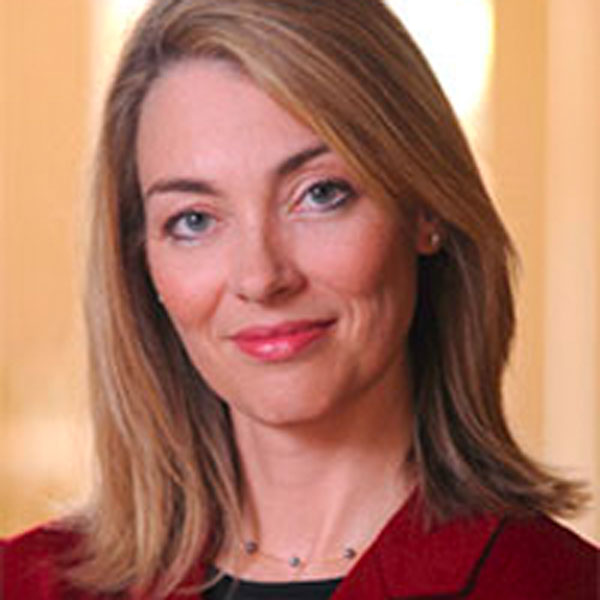
- Facebook Share on Facebook
- X/Twitter Share on Twitter
- LinkedIn Share on LinkedIn
A Rochester political scientist explains why the ‘clash of ideas’ resulting from free speech is necessary for a well-functioning university.
In September, the Foundation for Individual Rights and Expression released a survey of undergraduates on college campuses across the United States in an effort to gauge the state of free speech and expression in American higher education. Recruiting students from the College Pulse American College Student Panel, the organization sought to measure how comfortable students were in discussing controversial topics in various campus settings; how tolerant they were of campus speakers whose views were offensive to liberals; how tolerant they were of campus speakers whose views were offensive to conservatives; and how well or how poorly their institutions’ administration did in supporting a culture of free expression.
About David Primo
An expert on campaign finance laws, the federal debt, corporate social responsibility, and budget rules, David Primo is the author or coauthor of several books, including Rules and Restraint: Government Spending and the Design of Institutions (University of Chicago Press, 2007) and Campaign Finance and American Democracy: What the Public Really Thinks and Why It Matters (University of Chicago Press, 2020).
Among those polled were 250 University of Rochester students. Twenty-seven percent of the Rochester cohort said that they hesitate “fairly often” or “very often” to express an opinion out of fear of their professors’ or classmates’ reaction. The situation is not unique to Rochester; it exists on many US college campuses and follows a national trend, the survey found.
David Primo , the Ani and Mark Gabrellian Professor and a professor of political science and of business administration at the University of Rochester, has made promoting free speech and expression a pedagogical priority—bringing guests from across the political spectrum to his classes and teaching an undergraduate course devoted to the topic, Disagreement in a Democratic Society . Primo also directs the Politics and Markets Project, an initiative he created in 2014 to encourage robust but civil discussions about contentious policy issues.
During a recent campus event, Primo urged universities to remain steadfast in their historical role as places of discussion and dissent. The “clash of ideas is the foundation for a college education. Without that you can’t have a well-functioning university,” he said. “Ideas that shape the world often emerge from college campuses.”
Fortunately, in the United States free speech is legally enshrined in the First Amendment to the US Constitution, and many private universities (which are not bound by the First Amendment in the same way as public universities are) have explicit commitments to support free speech and free inquiry on their campuses. “In other words, students have the right to speak freely, debate speech, and also protest against speech they don’t agree with,” Primo explained. “Of course, some universities do a better job than others of living up to these ideals.”
Even at universities that uphold the principles of free expression, problems arise, according to Primo, when faculty and students become unwilling to express their own ideas or challenge each other’s. Primo argues the fear of being professionally or socially ostracized is often on the minds of those with unorthodox or unpopular perspectives.
So, what happens when students think they can’t speak freely—to professors, administration, staff, or each other?
“A fear of speaking out means that important ideas may not be heard, important discoveries may not be made, and the boundaries of knowledge may not be pushed,” Primo said. “That kind of self-censorship can also extend to faculty members and influence the kind of research projects they pursue, or feel they ought to pursue. The acceptable range of ideas narrows more than it should.”
Read on for more highlights from Primo’s remarks.
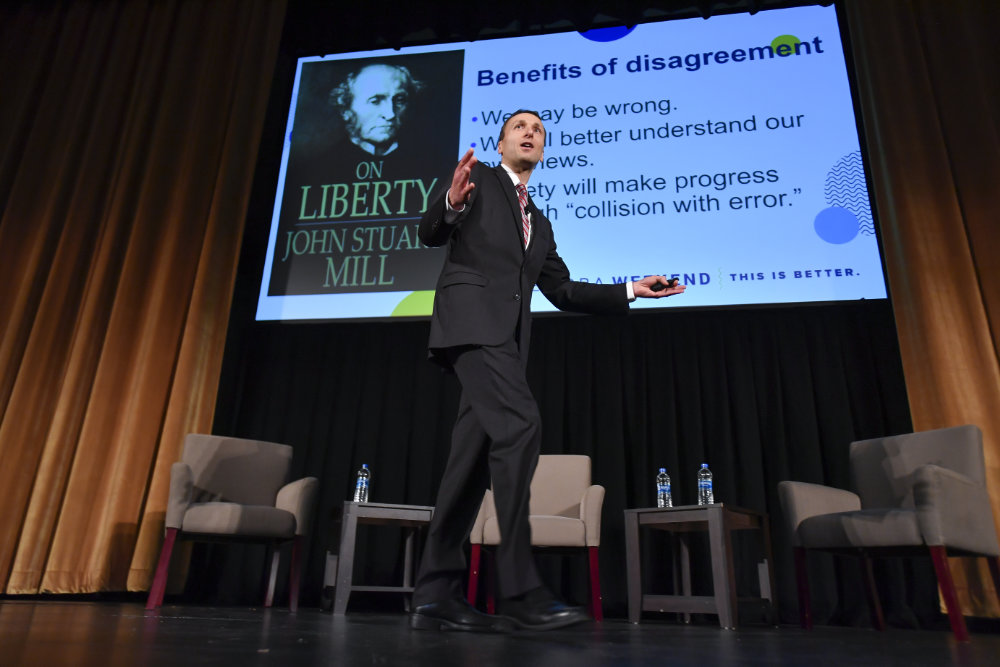
1. Heeding John Stuart Mill on the importance of ‘the heretics’
“You may say there are some people who just shouldn’t be able to speak—those crazy people on the left and those crazy people on the right. The 19th-century English philosopher John Stuart Mill had a name for these people—he’d call them the heretics, which was particularly appropriate given when he was writing, but I would argue is still appropriate now.”
Primo outlined three guiding principles on disagreement, distilled from Mill’s 1859 treatise, On Liberty :
- We should care about disagreement. We should interact with those we disagree with because we could be wrong. Otherwise we are assuming we’re infallible.
- You might understand your views on a contentious issue at a deeper level if you talk to someone who disagrees with you. It pushes you to understand your own ideas and positions better, and to learn to understand theirs.
- Society is going to make progress through error. That’s the hallmark of science: we have to be open to error and have ideas clash so that we can take the best parts of these ideas and move forward with knowledge generation.
2. On ‘affective polarization,’ or when politics became your identity
“When people’s political convictions become their identity—the blue team versus the red team—that’s what we political scientists call ‘affective polarization.’ Practically speaking, that means if I know that you’re a Democrat, I generally know much more about you than I would’ve known 30 years ago. Same if I know you’re a Republican. As a result, we’ve seen a rise in this idea that we don’t like somebody because they support the other party. In other words, it’s not just that we disagree with people on the other side; it’s that we actively dislike them as people because of their ideology or party affiliation.
“College students today are practicing affective polarization. In an NBC News poll a couple of months ago, nearly half of all college students said they wouldn’t room with somebody of a different political party. We ought to be figuring out exactly why that is—and how we can fix it.”
3. Responding to disinformation on social media
“There are serious issues with false information’s being transmitted on social media, but that’s something that we have to manage rather than regulate. Because if governments start limiting what can be said on social media, and if governments start regulating how social media companies moderate what’s allowed on their platforms, it becomes a slippery slope. Where then do you draw the line?
“When I think about restrictions on speech, I think about whether I would want those restrictions to exist when somebody I disagree with fundamentally is in a position of power. Because then they’re the ones who are going to control whether or not I can speak.”
4. Avoiding the ‘noise’ of MSNBC and Fox News
“Students need to cut through the noise and yelling on channels like MSNBC and Fox News and instead focus on having rigorous, courteous, civil debates. They should be shown why it’s important to care about the fact that we, as a society, are currently not disagreeing effectively.
“In class we have vigorous and valuable discussions, which signals to me that there’s a lot of support for the idea of open disagreement on college campuses. That’s why I am worried about the 27 percent of students who feel they can’t speak out. But I’m also heartened by the fact that we still have a tremendous number of students who are deeply engaged, who are willing to explore ideas. So, if we can help support them within the University then, that’s going to help because students are the ones who’ll be going out into society; they’re the ones who are going to be making the decisions and running the show in a few years. That’s why it’s vitally important they learn those skills here.”
5. Encouraging free speech among students—and supporting one another
“Students need to be supportive of each other as they explore ideas. On the first day of my seminar courses, I work with the students to set class norms and talk about the terms of debate in our class. One of the things we agreed upon this semester was that you can discuss outside of class what was said in class but not attribute specific ideas to specific people. I want students to be free to explore ideas without worrying that in two hours’ time what they just said in class would appear somewhere on social media. We want to have a truly safe space for the discussion of ideas without this fear. Of course, I can’t police whether students live up to these ideals. But I think the fact that students supported this ground rule shows that you can create this foundation to build up agreement to disagree on college campuses.
“When the heretics get to speak, I am reassured that we are protecting the right for all of us to express ourselves freely.”

A Rochester expert sheds light on the underrecognized challenges faced by college students recovering from trauma, and answers questions on the real meaning of trigger warnings.
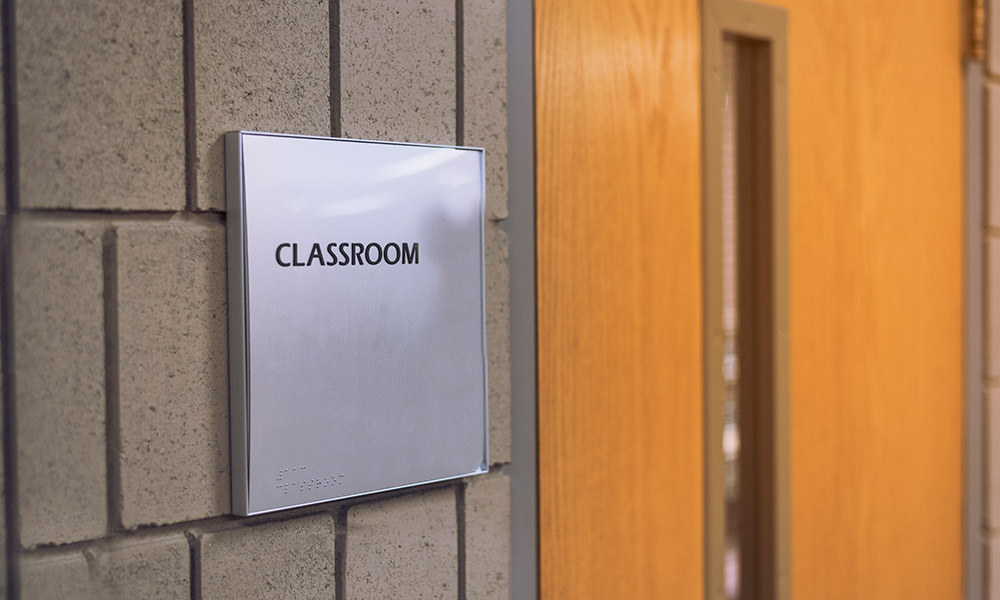
On college campuses, where safe spaces and free inquiry often coexist, do trigger warnings protect students or hinder free speech? This episode of the University’s Quadcast podcast takes on the growing debate.
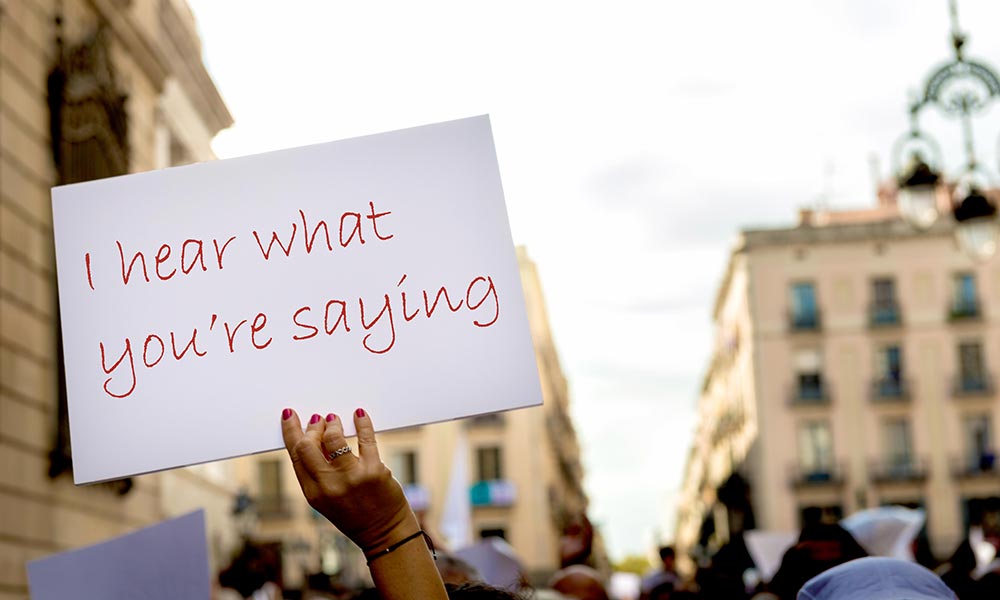
Three Rochester professors discuss the nature of America’s political and social divide and offer ideas on how higher education might help bridge the widening gap.
More in Society & Culture

- The Open University
- Guest user / Sign out
- Study with The Open University
My OpenLearn Profile
Personalise your OpenLearn profile, save your favourite content and get recognition for your learning

Why do we need free speech?
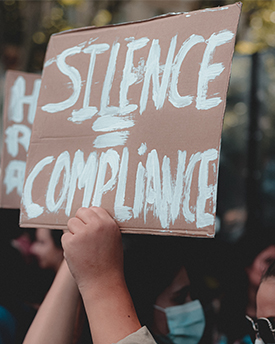
Meanwhile in the West, there have been worries that misinformation and disinformation spread through social media are undermining public trust in democracy. In January 2021, rioters stormed the US Capitol after false rumours circulated that the presidential election had been stolen. Five lost their lives, while faith in democracy was deeply shaken.
Even in the more peaceful world of universities, debates have also raged around the no-platforming and ‘cancelling’ of speakers on controversial issues. The current Education Secretary has tabled legislation to prevent ‘unacceptable silencing and censoring’ on campuses.
To understand why free speech matters, as well as how we might deal with the difficulties it faces today, we need to understand how the idea came about.
What is free speech?
Free speech refers to the right to express opinions without censorship or restraint. It is among the United Nations’ 1948 Declaration of Human Rights:
Everyone has the right to freedom of opinion and expression; this right includes freedom to hold opinions without interference and to seek, receive and impart information and ideas through any media and regardless of frontiers.
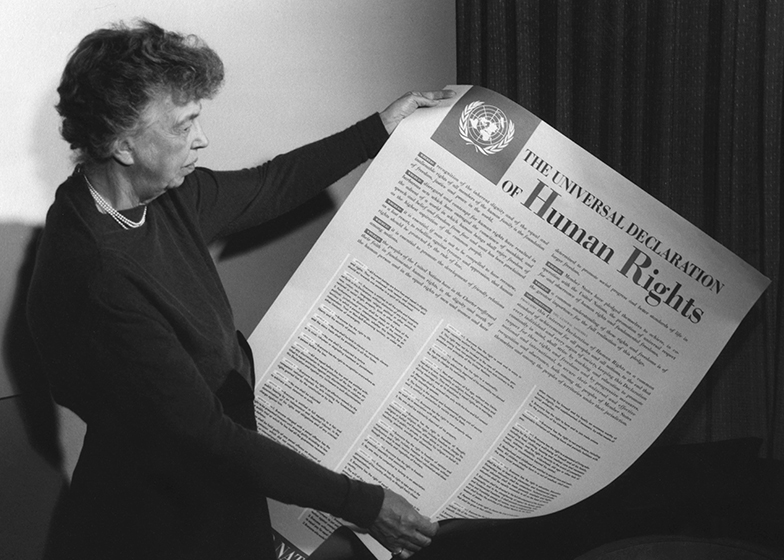
In On Liberty (1851), John Stuart Mill presents a now-classic argument for freedom of speech. Mill champions ‘absolute freedom’ of speech. It is a good thing for liberal societies, he says, because it allows as many people as possible to develop their understanding of what is true or false. Dogmas are challenged and minds develop.
The harm principle
For Mill, the only grounds for restricting free speech is ‘to prevent harm to others’ – the harm principle.
But in practice, drawing a line between the right to self-expression and the need to protect the public has been difficult. Hate speech, terrorism and extreme pornography all necessitate restrictions on what can be said or thought. But governments have sometimes used anti-terrorism measures to severely restrict the right to protest.

The traditional view also relies on free speech sharing values of pluralism, toleration and a shared commitment to underlying factual truths.
But what happens when societies become paralysed by the proliferation of false speech – of lies, untruths and conspiracy theories? Let’s look at one historical attempt that made the case for free speech and democracy in a time of mass fear and superstition.
In the Dutch Republic, then an unusually liberal society, the philosopher Baruch Spinoza was worried that the religious authorities were exploiting people’s fears to impose draconian restrictions on what people could say and think. One of Spinoza’s friends, Adriaan Koerbagh, had died in prison after being jailed for publishing his radical ideas. Spinoza worried for his safety.
In 1670, Spinoza set out to defend what he called ‘the freedom of philosophising’ in the anonymously published Theological-Political Treatise . He gave two arguments.
The case for free speech
First, freedom of speech is needed for rational inquiry, education and collegial debate, and these things enhance everyone’s lives. The true ‘end of the Republic is really freedom’, he wrote, and this freedom is achieved through democracy. By allowing the widest range of views to be expressed, democratic assemblies can listen and act on the widest range of information, thereby making wiser and more representative decisions and acting with the common good in mind.
For that to happen, citizens must be free to express themselves and must be consulted in public affairs. It also means placing a much higher value on education and citizenship to instil common values of toleration, curiosity and critical thinking.
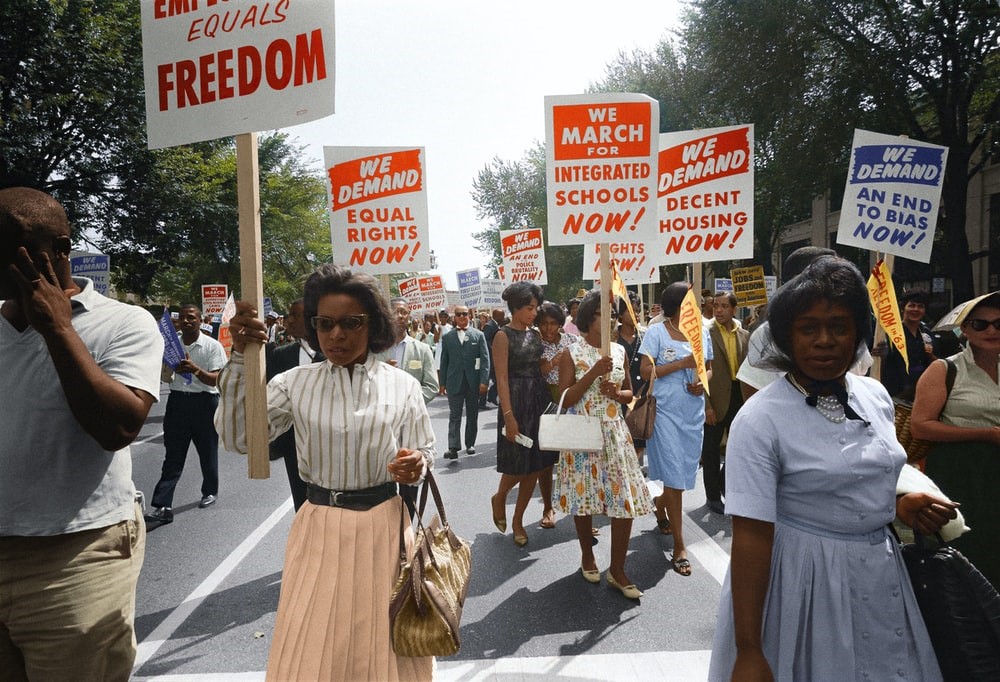
Second, no government could ever control what its subjects think, even if it tried. No-one can surrender their natural right to think and judge according to their own minds. At best, tyrants can intimidate subjects into never expressing what they believe. They can terrorise subjects into grudging obedience. But they cannot seize entirely our fundamentally human capacity to think and disagree.
Being heard
In our own time, periods of social upheaval and crisis are often accompanied by debates around restricting free speech. Spinoza teaches us that such efforts are inevitably doomed to failure. They make societies more unhappy and unstable, requiring further and further security interventions, and stifle rational thought and public life.

Yet some speech is more equal than others. Unless citizens in democracies are led to share values of truth, cooperation, equality and solidarity, we will often fail to understand what each other has to say.
Find out more about Spinoza’s Theological-Political Treatise through this event webpage here , and watch a talk below given by Marie Wuth of University of Aberdeen, as she discusses the uses of George Orwell and Spinoza to think about the negative role of hatred in public life.
Mill, John Stuart. (1982 [1859]). On Liberty . Harmondsworth: Penguin.
Spinoza, Benedictus de. (2016 [1670]). “Theological-Political Treatise”, in The Collected Works of Spinoza. Volume II , trans. Edwin Curley. Princeton: Princeton University Press.
United Nations. (1948). Universal Declaration of Human Rights : https://www.un.org/en/about-us/universal-declaration-of-human-rights.
Discover more articles like this

Trouble in paradise: The Dutch golden age
Dr Dan Taylor looks at troubles the Netherlands faced due to religious divisions and how this nearly led to the collapse of one of the wealthiest countries in the world.
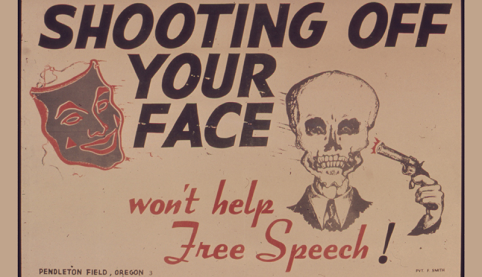
Freedom of speech
Should there be limits to freedom of speech? Professor of Philosophy, Derek Matravers, explores this idea.
Study a free course on human rights and politics

Human rights and law
Human rights now seem to take precedent over many areas of our lives, but where do these rights come from and how did they develop? This free course, Human rights and the law, looks at the impact of the European Convention on Human Rights and its influence on law in the UK and examines the Human Rights Act 1998.

What is politics?
This free course, What is politics?, introduces you to the world of politics. It is dedicated primarily to answering the question of what politics is. Although the question might seem rather simple, it elicits various, often contradictory responses. As you will realise, in politics as in much of the humanities and social sciences definitive ...
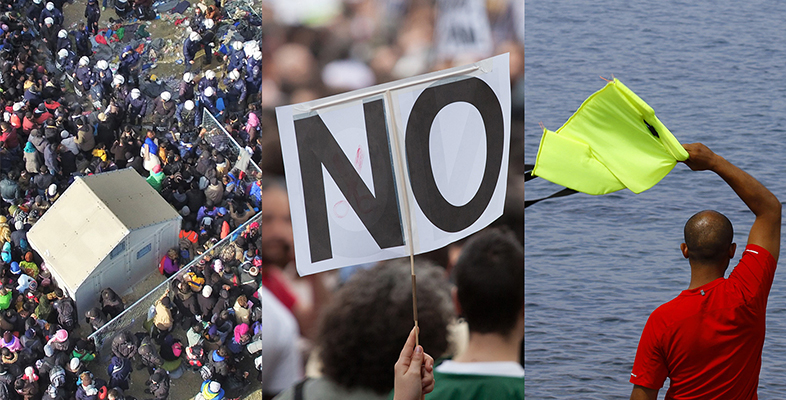
Social psychology and politics
Why are social psychologists interested in politics, and how can they help us understand things like social movements, protest and activism? This free course, Social psychology and politics, moves away from a state-centric study of politics and, using insights from social psychology, explores the role of identity, personality and culture for ...
Become an OU student
Ratings & comments, share this free course, copyright information, publication details.
- Originally published: Tuesday, 18 May 2021
- Body text - Creative Commons BY-NC-SA 4.0 : The Open University
- Image 'Person holding a sign for free speech' - Image by Mathias P.R. Reding on pexels.com under Creative Commons BY-NC-SA 4.0 license
- Image 'Eleanor Roosevelt holding poster of the Universal Declaration of Human Rights (in English), Lake Success, New York. November 1949.' - FDR Presidential Library & Museum under Creative-Commons license
- Image 'Publicity photo on the set of the CBS anthology television series Studio One - a presentation of George Orwell's 1984' - CBS Television under Creative-Commons license
- Image 'Civil rights march on Washington, D.C' - Copyright free: Image uploaded to Unsplash by Unseen Histories.
- Image 'Speakers' Corner in Hyde Park' - Image by Willem van de Poll. under Creative-Commons license
- Image 'Why do we need free speech?' - Image by Harun Tan on pexels.com under Creative Commons BY-NC-SA 4.0 license
- Image 'Social psychology and politics' - Copyright: © lacimolnar / iStockphoto.com; © ericcrama / iStockphoto.com; © Michael Debets / Alamy Stock Photo
- Image 'Freedom of speech' - Copyright free: Unknown under CF licence
- Image 'What is politics?' - Copyright free
- Image 'Human rights and law' - Copyright: Used with permission
- Image 'Trouble in paradise: The Dutch golden age' - Copyright free: Schloss Köthen (Anhalt)
Rate and Review
Rate this article, review this article.
Log into OpenLearn to leave reviews and join in the conversation.
Article reviews
For further information, take a look at our frequently asked questions which may give you the support you need.
Academia.edu no longer supports Internet Explorer.
To browse Academia.edu and the wider internet faster and more securely, please take a few seconds to upgrade your browser .
Enter the email address you signed up with and we'll email you a reset link.
- We're Hiring!
- Help Center

Why Higher Education Leaders Should Support Free Speech

2021, Academia Letters
Related Papers
Academia Letters
Alaric Naudé
In the Western World, Universities have been held in high regard as institutes of higher learning where complex and at times highly controversial ideas could be openly critiqued and studied from the vantage point of neutrality. Yet, proud traditions of open discourse are slowly being eroded by those who do not desire open inquiry and who insist that academia bow to a narrow, pseudoscientific and flawed view of the world, all without the ability to even dare question its validity. Even once proud Universities have begun to succumb to this intellectual rot, the giants of education, the University of Oxford which dates to at least 1167 (Oxford, 2018), and University of Cambridge have discarded their traditions of open inquiry and lay prostrate before destructive ideologies that pit men and women against each other, and drive a wedge deeper between already unstable race relations (Cambridge Equality & Diversity, 2020). Across the United States, Australia, New Zealand, Canada and the UK, universities have slowly but surely begun to bow to the intellectually immature rather than uphold freedom of speech, open inquiry and freedom of thought. The history of open inquiry and free speech in academia has been a centuries long battle, a battle between those who desire to think and those who desire to tell others what to think. For centuries those who would censor academic inquiry have recycled the same methodologies to intimidate and de-platform those who would not follow the narrative. Today, large swathes of academia have already succumbed to the relentless tide of Philistinism. Academia has become the proverbial canary in the coal mine and what happens in universities is of great importance as they are a microcosm of what wider society will inevitably become
Postdigital Science and Education
Dennis Hayes
Philosophia
Sandra Dzenis
As understood today, political correctness aims at preventing social discrimination by curtailing offensive speech and behaviour towards underprivileged groups of individuals. The core proponents of political correctness often draw on post-modernism and critical theory and are notorious for their scepticism about objective truth and scientific rationality. Conversely, the critics of post-modern political correctness uphold Enlightenment liberal principles of scientific reasoning, rational truth-seeking and open discourse against claims of relativism and oppression. Yet, both the post-modern proponents and their Enlightenment liberal critics make up two sides of the same phenomenon of political correctness. Both sides intend to protect a liberal value system from illiberal truth-claims, which is the function of politically correct regulation. While post-modern advocates attempt to promote liberating tolerance, Enlightenment liberals place liberal values above the open-ended search for truth. Despite appearances to the contrary, this socio-academic debate is not about two sides favouring and opposing political correctness. In fact, it is a debate about the type of politically correct regulation that can better guard liberal values.
Evelyn C H I Y E V O GARWE
Carrie Prior, Ed.D.
Abentin Estim
Yannick Bowe
Kathy Lund Dean
Shaista E Khilji
Hershey H Friedman
RELATED PAPERS
dean cristol
Deniz Gokcora
Nancy A Watkins
Zubair Torwali
Haven Allahar
Michael Bellesiles
Mark Camilleri
G. Jason Jolley
Lorri J. Santamaría
Andree' L . Koehler
Shiraz Durrani
Pat O Connor
Donna Bain Butler, Ph.D.
Brigid Freeman , Ian Teo , Pete Leihy
Katniyon H E N R Y David
Vendulka Kubalkova
Ivana Pondelíková (Styková)
kalliopi billiri
Igor Valentim
Irv Glenn, II
Jacqueline Getfield
Ehikioya O S O L A S E Hilary
kathleen buddle
Social Movements for Gender and Sexual Diversity: Case Studies from Jamaica, Nepal, and Japan
Diana J . Fox
Peter Zitko
Kristin Lems
Nazneen Akhter
Diana J Fox
Dr. Milan Frankl
Jace Hargis
Enrico Mestieri
Navaneeta Majumder
Greg Gumina
Robert E Wright
Terrell L Strayhorn
Pradeep Gupta , Dr. Akansha Sharma
Dr. Gil R . Ontai
- We're Hiring!
- Help Center
- Find new research papers in:
- Health Sciences
- Earth Sciences
- Cognitive Science
- Mathematics
- Computer Science
- Academia ©2024
Free education is a worthy goal, but South Africa isn’t ready for it yet
Visiting Adjunct Professor, Public and Development Management School, University of the Witwatersrand
Disclosure statement
Graeme Bloch does not work for, consult, own shares in or receive funding from any company or organisation that would benefit from this article, and has disclosed no relevant affiliations beyond their academic appointment.
University of the Witwatersrand provides support as a hosting partner of The Conversation AFRICA.
View all partners

Free education in South Africa is a goal worth pursuing, especially for students who are poor and want access to tertiary institutions and those who correctly see it as a right and developmental imperative for the country. Germany has attained it .
The huge challenge is to make the slogan of “free education” a reality. There is not enough money from any source. And government, as the biggest subsidy provider, is not doing well.
South Africa is lowish in world terms for tertiary funding. A task team established by the country’s ministry of higher education and training to investigate funding in the sector reported that the budget for universities as a percentage of GDP was just 0.75%. The Africa-wide proportion is 0.78% and the global proportion is 0.84%.
For countries that belong to the Organisation for Economic Co-operation and Development – among them Germany, Australia, Finland, Mexico and Turkey – the proportion is 1.21%.
South Africa’s main sources of university funding are fees – which have sparked the current dispute – government subsidies and third-stream endowment and convocation or alumni input.
But all of these sources are under pressure.
Subsidies floundering
Government subsidies are determined by student numbers and the number of accredited articles produced by a university’s academics and researchers.
Since 1994, the number of people enrolling at South Africa’s universities has almost doubled . Historically disadvantaged universities such as the universities of Venda and Fort Hare and Vaal University of Technology were under-funded by the homeland states and apartheid institutions such as the Coloured Affairs Department . These have since come under the democratic government’s funding ambit.
Student demographics changed, too, with more black South Africans enrolling. Many come from poorer families and simply cannot afford the fees charged by universities.
There are many problems for the government, including the state of the world economy, which ensures that there is not enough money. Yet it needs tertiary graduates for developing the country and filling the many gaps in delivery.
So, pressure on universities becomes pressure on students, and raising fees becomes an easy target. Parents, too, are affected by the world economy and can no longer afford increases or to pay. I know a student who could not afford even the cheapest form of transport to get to the University of Johannesburg so dropped out and became a garage attendant – luckily, since jobs are scarce and unemployment rates are so high.
Endowments or investment income barely warrant a mention as a funding source, since they are hardly enough in South Africa to plug the gap. Third-stream income from endowments is mostly available to long-established institutions like the universities of the Witwatersrand and Cape Town, rather than the newer universities. These more established institutions in urban centres are also able to generate rental income, such as by leasing space to a hotel or a hospital.
Moving forward
There is thus a need to set targets and plan. Yet universities are autonomous from government. The National Development Plan is an aspiration. But unless institutions agree to fall in line, the plan cannot achieve results.
Students need to get off campus and convince society of their needs, though they also need to convince fellow students. This is done through discussion, hard as it may be.
There is not enough money. There is a challenge that needs a discussion of what tertiary education is for and how many graduates we need. Money cannot come from social grants or basic education or health. So, there is a huge challenge for South Africa.
- University fees
- Student protests
- Free Education

Research Fellow

Senior Research Fellow - Women's Health Services

Lecturer / Senior Lecturer - Marketing

Assistant Editor - 1 year cadetship

Executive Dean, Faculty of Health

IMAGES
VIDEO
COMMENTS
Reducing Student Loan Debt and Financial Insecurity. One of the most immediate effects of tuition-free education is the reduction of student loan debt . Students who graduate without the burden of debt have more financial freedom and security, enabling them to contribute economically through higher consumer spending and investments.
The more skilled labor that exists in a country, the more economic growth that country experiences. 5. Free Education Attracts Tourists. If education is free in a country, that country records a rise in tourists coming to enjoy the top-notch education system. This in turn leads to diversity and economic growth. 6.
The image is one of adequate space to do your work, secure in the knowledge that nobody is looking over your shoulder to enforce ideological conformity. For the university to do its job of ...
Learn how Human Rights Watch advocates for free education for all children, regardless of caste, race, gender or disability. Read the article and join the campaign.
India's government must make education free in order to unify and spread the country's educational system. Every child has the right to an education, but not every child is born into a stable family. As members of the postmodern age of civilized and educated people, we can do our part by establishing private institutions where we can give ...
Administrative awakenings in relation to free speech on college campuses are the result of student activism, and also the fact that universities are a primary target in the current culture wars, Ben-Porath says. University leaders have trepidations about how the higher education sector is perceived. She says where a person stands on the issue ...
Even after California recently expanded free tuition opportunities, enrollment at its community colleges fell by nearly 15 percent in 2021 from a year earlier. The push for tuition-free higher ...
Michelle Obama reinforced how education is of key importance: "The ability to read, write, and analyze; the confidence to stand up and demand justice and equality; the qualifications and connections to get your foot in the door and take your seat at the table—all of that starts with education.". 2. Free Education.
The "Knight-Ipsos College Student Views on Free Expression and Campus Speech" report is the fourth in a series of Knight Foundation reports measuring college student attitudes toward speech and the First Amendment since 2016. For this report, Knight Foundation commissioned Ipsos to conduct a survey with a nationally representative sample of over 1,000 college students ages 18-24 enrolled ...
155 countries legally guarantee 9 years or more of compulsory education. Only 99 countries legally guarantee at least 12 years of free education. Eliminating inequalities and disparities in education. While only 4% of the poorest youth complete upper secondary school in low-income countries, 36% of the richest do.
College students overwhelmingly say that they value free speech. When given the choice of whether it was more important to "protect students by prohibiting speech they may find offensive" or to "allow students to be exposed to all types of speech even if they may find it offensive or biased," 81% of students surveyed said they favored ...
Updated 11:58 AM PDT, August 15, 2023. The presidents of a wide-ranging group of 13 universities are elevating free speech on their campuses this academic year, as part of a new nonprofit initiative announced Tuesday to combat what organizers call dire threats to U.S. democracy. The Campus Call for Free Expression will take different forms on ...
By Jeremy Engle. April 20, 2023. Last month, Stuart Kyle Duncan — a federal appeals court judge appointed by former President Donald J. Trump — visited Stanford Law School to give a talk, but ...
Increasingly, evidence says yes. In just a few short years, the idea of free college has moved from a radical idea to mainstream Democratic thinking. President Biden made free college one of his ...
But it also means protecting the vigorous exchange of divergent, even provocative, views. In recent years, debate has arisen about the state of free speech and free inquiry on college campuses ...
NPR's Steve Inskeep asks the president of the American Council on Education, Ted Mitchell, about rights and limits to free speech on college campuses. STEVE INSKEEP, HOST: All right. We now know ...
Chemerinsky said the campus encampments raise free-speech issues more than academic freedom worries. Encampments can violate "time, place and manner restrictions" on free speech, depending on campus policies and the nature of the encampment. Even if the right to protest is considered an academic freedom issue, he said, academic freedom ...
That policy prohibited speech that did little more than cause hurt feelings. Preventing harassment does not require unnecessarily restricting free speech. In fact, harassment is less likely to occur in schools where ideas can be freely and respectfully exchanged. School districts can prevent harassment and respect students' First Amendment ...
Freedom of speech is an important right because a person's voice is sometimes all that person has. To take away a person's thoughts and opinions is to diminish their values and strip their ...
Political scientist David Primo has made promoting free speech on college campuses, including at the University of Rochester, a pedagogical priority. (University of Rochester / Adrian Knaus) 1. Heeding John Stuart Mill on the importance of 'the heretics'. "You may say there are some people who just shouldn't be able to speak—those ...
To understand why free speech matters, as well as how we might deal with the difficulties it faces today, we need to understand how the idea came about. ... It also means placing a much higher value on education and citizenship to instil common values of toleration, curiosity and critical thinking. Civil rights march on Washington, D.C, 1963.
ACADEMIA Letters Why Higher Education Leaders Should Support Free Speech Taylor Overbey Higher education's principal role is "the discovery, improvement, transmission, and dissem- ination of knowledge by means of research, teaching, discussion, and debate" (Kurtz et al., 2017).
EPA/Nic Bothma. Free education in South Africa is a goal worth pursuing, especially for students who are poor and want access to tertiary institutions and those who correctly see it as a right and ...